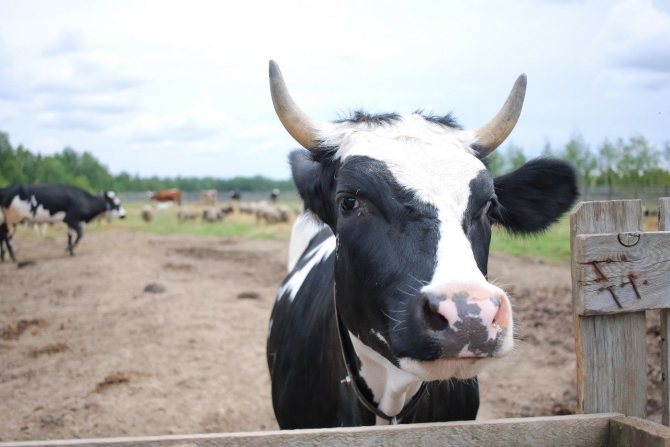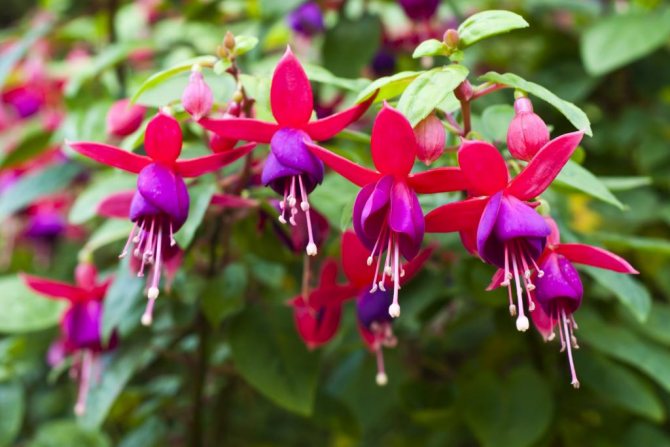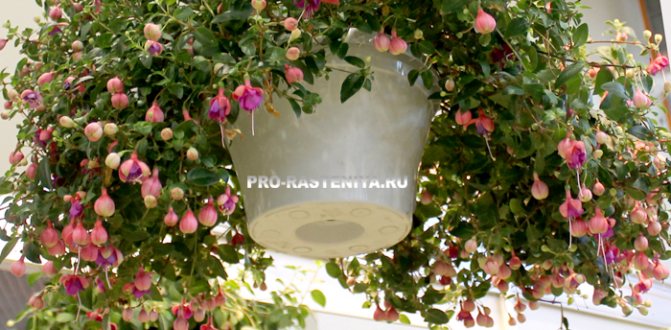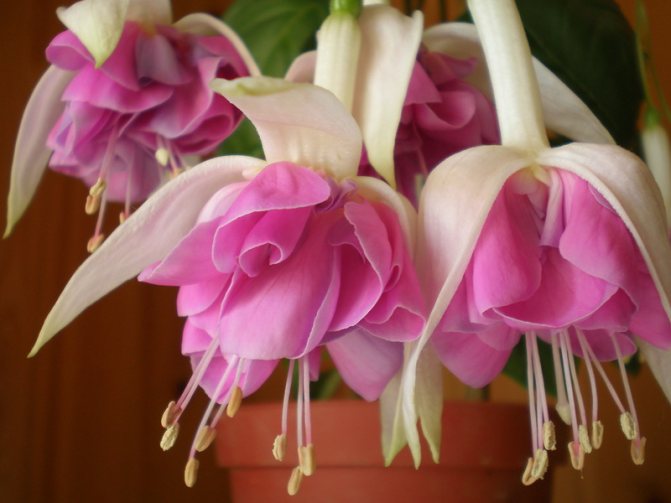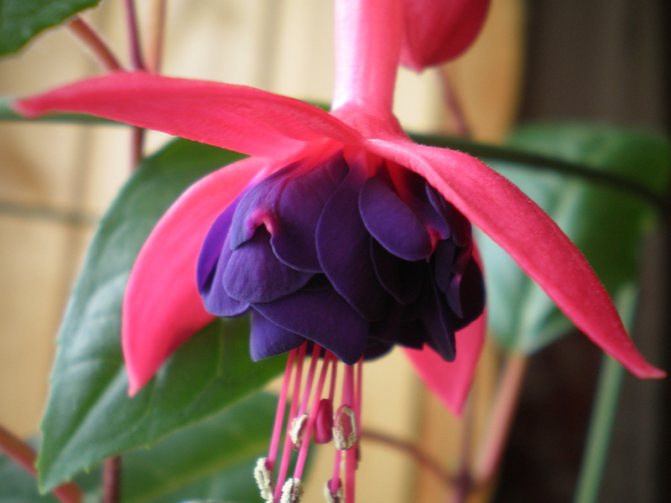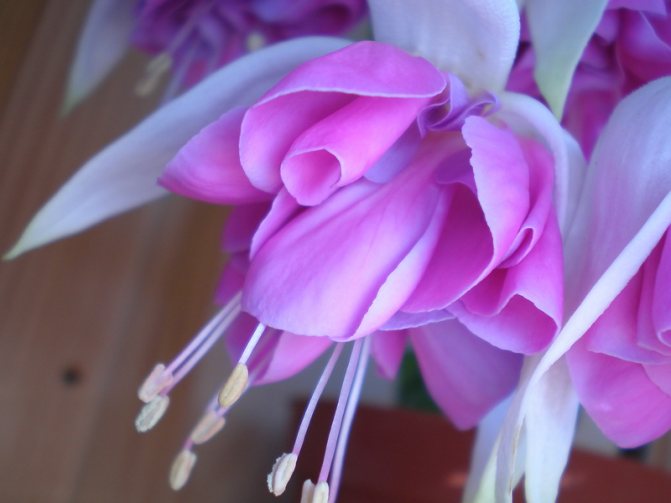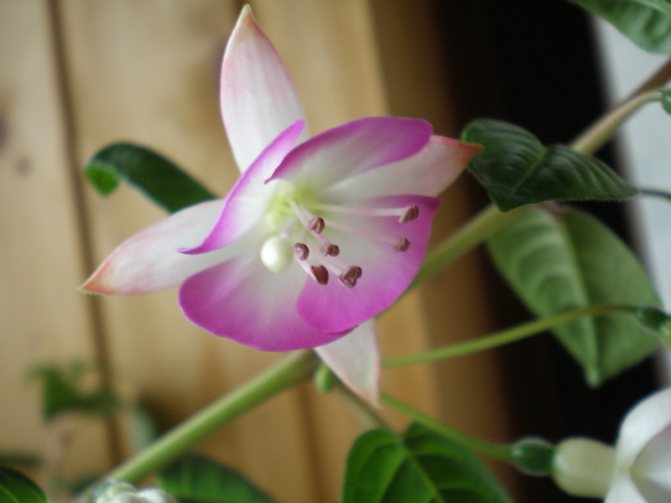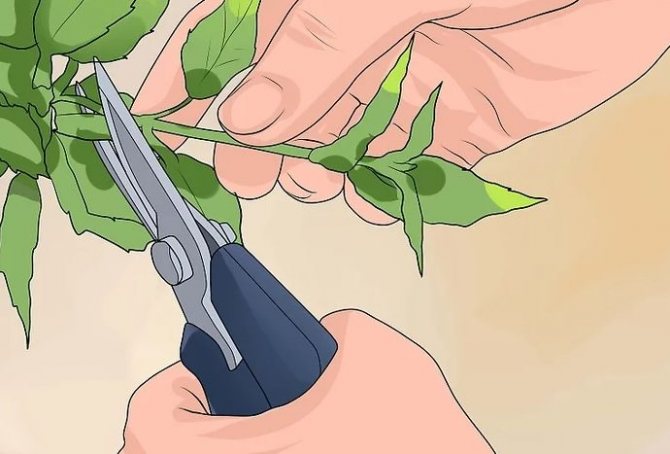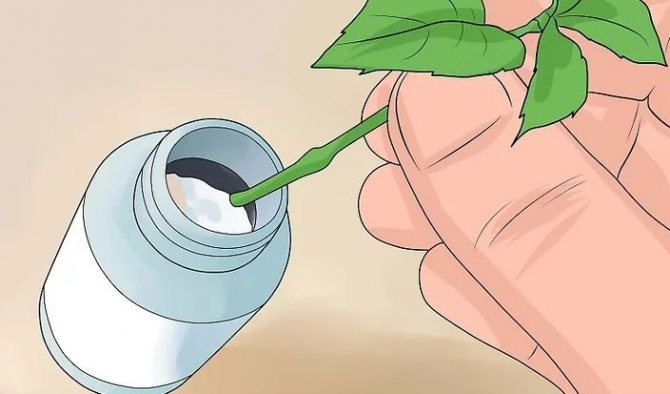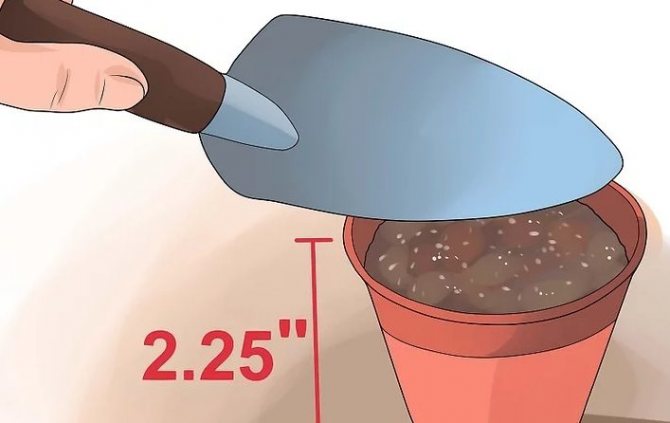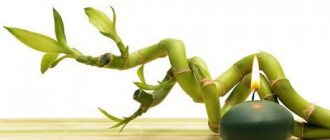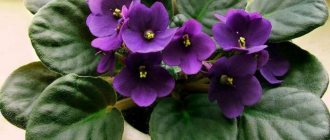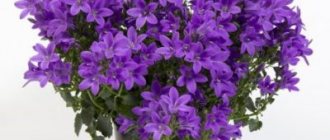Luxurious flowering, a variety of varieties and shapes, unpretentiousness and plasticity - this is why flower growers all over the world love fuchsias so much. They can be grown at home and on the street, they can be formed into beautiful bushes, standard trees or "waterfalls" running down from hanging baskets or balcony boxes. And although fuchsias do not hibernate in open ground in Russia, since they only tolerate small frosts, they are still real perennial plants that do not cause unnecessary trouble in growing and reproducing. It is worth getting at least one fuchsia, and every year you can admire its many bright flowers, similar to ballerinas in fluffy skirts.
Description
The magnificent variegated ampelous fuchsia with abundant flowering is a sport of the Marinka variety. The plant is weakly branched, shoots are small - up to 30 cm long, flexible, hanging. The flowers are simple or semi-double, medium in size. The sepals and skirt are scarlet, catchy. Beautiful variegated leaves in yellow-green tones add decorativeness to the variety. Strong shoots do not break off, but they do not lignify either; for a beautiful look, pinching of the apical buds is needed. Does not tolerate excessive moisture, cuttings take root slowly.
Plant characteristics
Size: Height up to cm: 30 Diameter up to cm: - Flowering time: May-October
Planting and leaving
For propagation of fuchsia, cuttings are used. Young apical parts of shoots, 15 cm long, are taken for cuttings. Rooting takes place in settled water. It is noticed that the rooting process proceeds faster in a dark glass container. The soil should be loose, nutritious, you can use soil for indoor plants with the addition of perlite, humus, sand and vermiculite. You can add charcoal and coconut fiber.
From the end of May, it is advisable to feed the plant. Any fertilizer for flowering plants will do. You can use trace elements and Kemiru-lux, as well as many fertilizers, which include phosphorus and potassium. Fuchsias react to fertilization with an abundance of foliage and inflorescences. Plants are fed during the period of intensive growth, budding, flowering and before the winter period. They are fed with an intensity of 1 time per 10 days. Fuchsia prefers diffused light. Small fuchsias can be illuminated with artificial lighting until they get stronger. Water the plant sparingly. In summer, it is recommended to spray the plant with cool water. With the onset of autumn, it is enough to water the flower once every 2 weeks.
Payment and delivery
To buy Fuchsia hybrid ‘Golden Marinka’ red, variegated Fuchsia x hybrida ‘Golden Marinka’, you just need to put the product in the basket and place an order, or come to our garden center and personally see, get advice on plants, planting and care. Details on the payment and delivery page
What is being planted next to?
Fuchsia hybrid 'Dark Ice' red-violet Fuchsia x hybrida 'Dark Eyes'
Fuchsia hybrid 'Lambada' pink-lilac Fuchsia x hybrida 'Lambada'
Fuchsia hybrid 'Bella Rozella' white-pink Fuchsia x hybrida 'Bella Rozella'
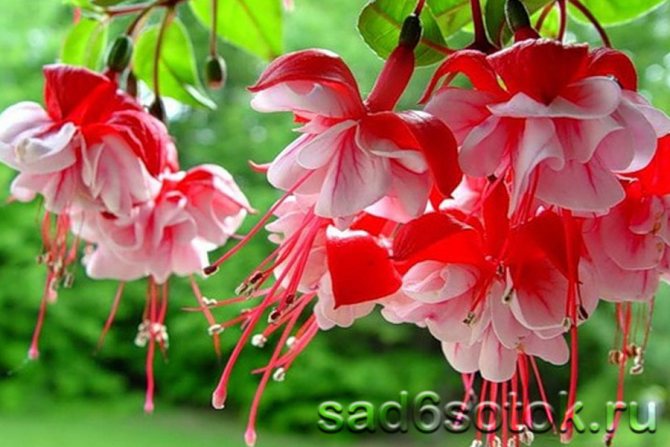
Fuchsia - growing and care
The colorful, spectacular fuchsia flowers are like fabulous little dancers, with their fluffy skirts of various shades. These plants look great in the interior, numerous varieties can be formed in the form of compact bushes, small trees or bushes drenched with flowers, as well as in ampelous form.
reference
The genus fuchsia (Fuchsia) belongs to the Cypriot family, i.e., in addition to our well-known ivan tea (fireweed). More than 100 species of fuchsia are known - perennials, shrubs or small trees growing in the subtropical and tropical zones of Central and South America, as well as on islands from New Zealand to Tahiti.In culture, f. three-leafed (F. triphylla) and f. hybrid (F.x hybrida).
Three-leafed fuchsia is a plant up to 60 cm high with straight semi-woody stems growing from the rhizome, and large leaves with a dark burgundy underside. It has graceful, tubular, bright coral flowers 5–6 cm long, collected in a short raceme. Varieties with its participation are allocated in a separate group, but there are significantly fewer of them than that of hybrid fuchsia.
F. hybrid obtained as a result of numerous crosses with the participation of F. fiery red (F. coccinea), f. sparkling (F. fulgens), f. magellan (F. magellanica) and other species. The bush can be upright in shape, spreading and ampelous (creeping or falling down) and have a height of 30 to 70 cm.In most varieties, the flowers hang down, but the bushes in which they are collected in small inflorescences and look upward look no less elegant.
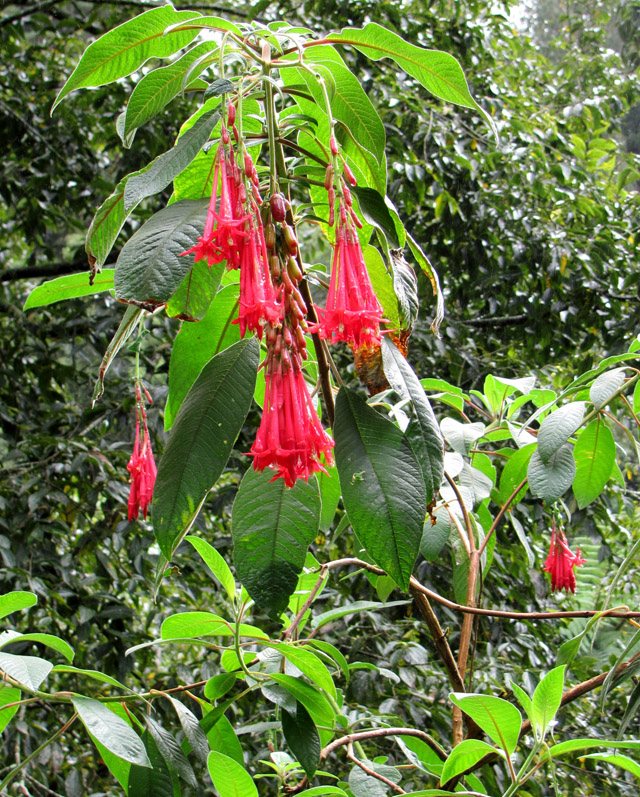

Fuchsia three-leafed. Photo by the author
Forms and varieties
In home floriculture, hybrid fuchsia is most often grown - a group that includes more than two thousand varieties of delicious shades, each of which deserves the attention of a florist and will wonderfully decorate a room, balcony or veranda.
The shape of the bush and the type of growth are distinguished bush, ampel and semi-ampel types. This division is rather arbitrary, since in many ways the appearance depends on the formation and growing conditions.
Shrub fuchsia (erect)


Shrub fuchsia (erect)
The most common form, which is characterized by erect, frequent branches from 35 to 90 cm long. Oblong-oval, serrated leaves opposite on long petioles. The flowers are collected in loose clusters or single, located in the axils of the leaves and hang down like luminous lanterns.
It is the bush type that is most often used to create standard forms, breaking off all lateral shoots and allowing fuchsia to grow only at the top or, for greater effect, grafting one of the ampel varieties onto the stem.
How to grow a rose in the form of a stem, read in the article "Standard roses - planting".
Ampel fuchsia
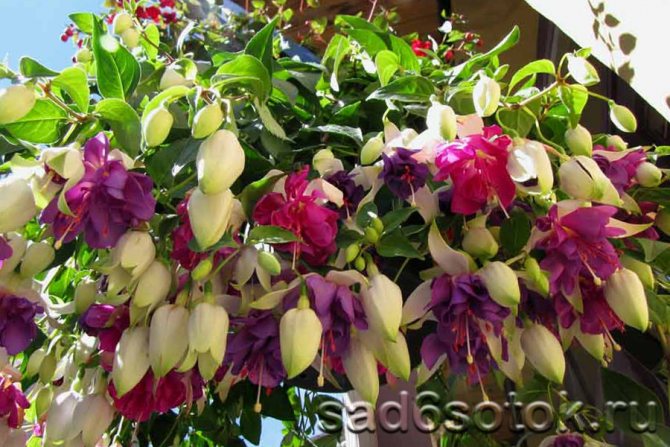

Long flexible stems of ampelous fuchsia fall freely, which makes it possible to plant plants in pots, decorate verandas and terraces with them. The flowers are medium to very large, of various shades, double, semi-double and bicolor. For more lush flowering, several cuttings are planted in one pot.
Ampel forms, grafted onto a stem, allow you to get attractive tall trees with a weeping crown. Hanging fuchsias develop well in partial shade, do not like direct sunlight and drafts, which is taken into account when placing.
Semi-ampel fuchsias


At the initial stage, semi-ampelous varieties look like typical bush forms with erect shoots, which eventually droop, hanging under a load of heavy flowers, and the bush takes on an ampelous appearance. Lush flowers can break off shoots, so they are tied to supports. The appearance and development of such fuchsia largely depends not only on the variety, but also on the formation, and some species can be successfully grown as trees.
Indoor fuchsia flower: photo and description
Fuchsia (Fuchia) belongs to the family Onagraceae. Homeland - Central and South America, New Zealand.
The genus includes about 100 species, with some photos and names of fuchsias you can find on this page.
As a room culture, they grow:
Fuchsia hybrid (F. hybrida).
Fuchsia graceful (F. gracilis).
When describing a fuchsia flower, it is worth emphasizing that this amazingly beautiful and unpretentious plant, widespread in indoor floriculture, belongs to one of the many genera of the fireweed family. The genus is named after L. Fuchs (1501-1566), a German physician and botanist.It was brought to Europe a long time ago, about 300 years ago from Central and South America, where it was very widely cultivated and where it grew wild for a long time.
Fuchsia is an evergreen shrub that grows up to 1 m in height with reddish stems. Leaves are opposite, axillary; the leaf plate is oval-lanceolate, toothed, 4–5 cm long. The fuchsia plant has flowers on drooping pedicels, varied in color (pink, purple, etc.). The fruit is a black berry.
There are more than 600 species of fuchsia and many varieties with double and non-double coral, white, crimson flowers, and in double forms and species, two-color ones - red petals in the middle and purple outer or white in the middle and crimson outer (there may be other combinations of colors, depending on from variety, species).
As you can see in the photo, in a houseplant fuchsia, the stamens and pistils protrude far beyond the corolla, which gives the flower an elegant look:
Below you can find photos and tips for the care and cultivation of fuchsia on your windowsill.
Bush varieties


Fuchsia bush variety Rohees New Millennium (Rohees New Millennium)
Rohees New Millennium
A compact bush with erect shoots up to 40 cm high, all covered with medium-sized double flowers with black cherry skirts and light purple sepals. This unusual combination gives an attractive contrast and looks exotic. One of the best dark-colored varieties easily propagates by cuttings, and woody, strong shoots make it suitable for tree formation.
Ampel fuchsia


One of the most popular varieties of fuchsia is ampelous. She has a number of features that have pleased many flower growers. For example, it has very flexible stems that fall down in a cascade. They are strewn with bright colors that catch the eye. Pink fuchsia looks very beautiful, as well as its two-tone varieties. These ampelous flowers are most often grown in pots and hanging baskets.
Ampel varieties


Fuchsia ampelous grade Isisl (Icicle)
Golden Marinka
The magnificent variegated ampelous fuchsia with abundant flowering is a sport of the Marinka variety. The plant is weakly branched, shoots are small - up to 30 cm long, flexible, hanging. The flowers are simple or semi-double, medium in size. The sepals and skirt are scarlet, catchy. Beautiful variegated leaves in yellow-green tones add decorativeness to the variety.
Strong shoots do not break off, but they do not lignify either; for a beautiful look, pinching of the apical buds is needed. Does not tolerate excessive moisture, cuttings take root slowly.
Isisl (Icicle)
A vigorous bush develops rapidly, shoots of a reddish hue, graceful, slightly lignified, leaves of a juicy green tone with reddish-brown veins. It blooms profusely, the flowers are large, the sepals are long, cream-white, pointed, greenish at the ends, the skirt is light pink. Leaves and shoots are burned in the sun. Cuttings take root with difficulty.
First Love
The variety is characterized by strong growth and branching, lush flowering, large, full flowers, elongated buds. Leaves are elongated-oval, leathery, moderately green. Sepals are snow-white, from above as if pollinated with pinkish powder. The skirt is pale lilac, with a pink blush at the base. The cuttings take root slowly.
Plant structure
Roots
The plant has a powerful and developed root system. Because of this, it easily tolerates transplantation and reproduction.
An important condition for growing is the constant access of air to the roots. To do this, you will periodically have to loosen the soil and use light soil.
Leaves
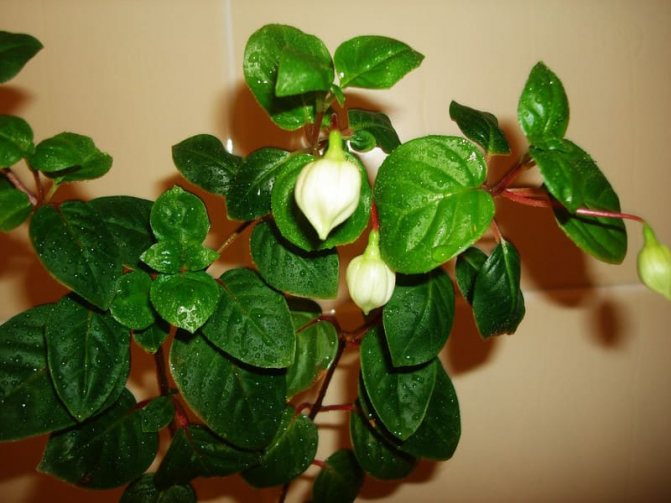

The leaf plates in most plant varieties are oval with a sharp tip. Although there are specimens with ovoid and lanceolate leaves.
The color of the leaf plates is green (there are varieties with a reddish tint). The edge may be jagged.
The leaves grow on petioles that have a noticeable reddish tint.
Flowers


Flowers are the main decorative part of the plant. They grow on peduncles. Depending on the variety - separately or in inflorescences. It is because of the appearance of the flowers, which are similar to the silhouette of a woman in a skirt, that Fuchsia is popularly nicknamed "Ballerina".
The shape and shade of flowers can be different. There are both monochromatic and two- and three-color specimens.
The flower consists of sepals, tubular petals and long yellow stamens.
The petals can be simple or double to the touch.
INTERESTING. In some countries, Ballerinas' flowers are used to decorate culinary dishes, mainly desserts and salads.
Fruit
Fruits in small, dark, slightly elongated berries, similar to the black chokeberry.


Unlike most other houseplants, Fuchsia fruit is edible. They taste sweet, slightly tart. In countries where Ballerinka grows in natural conditions, various tinctures, liqueurs and jams are prepared from its fruits.
Semi-ampel varieties
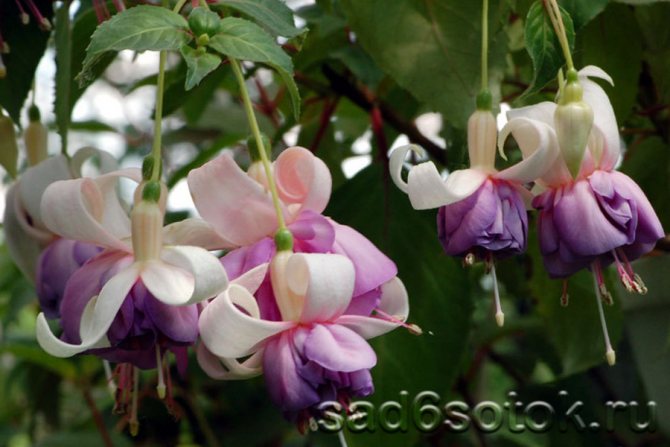

Fuchsia semi-ampel grade Fey (Fey)
Fairy (Fey)
Medium-sized shrub with flexible self-branching shoots up to 35 cm long and lush early flowering. Large leaves are rounded, decorated with brown veins. The flowers are densely double, long sepals of ivory color with a light pink tone are pointed at the ends and raised, the skirt is silky, lilac-blue.
An amazingly beautiful fantasy variety is rather unpretentious, develops quickly, the shoots become lignified and are suitable for the formation of boles.
Golden Monique
A very spectacular sport of the famous Peppermint Stick variety is distinguished by a beautiful golden yellow tone of leaves with reddish veins. Sepals are small, deep pink, the skirt is purple with a pinkish tinge.
The plant is weak, branching, woody shoots, suitable for forming in the form of a tree. Easily propagated by cuttings. With a lack of light, the leaves turn green.
La Fiesta
Medium-sized variety with small, strong branching shoots up to 40 cm long, covered with rich green leaves and purple veins. Abundant flowering, elongated buds are large, light creamy tone with a green tint. Sepals are oblong, snow-white with greenish tips; the skirt is crimson-red with pale pink strokes. Rooting of cuttings is slow.
Signs and superstitions associated with Fuchsia
It is no wonder that so many interesting signs and beliefs are associated with such an unusual plant like Fuchsia.
- Fuchsia protects the house from negative external influences.
- The ballerina is the patron saint of creativity and creative professions.
- Gypsy earrings can be safely presented to newlyweds and newcomers. Fuchsia will help them to establish a life in a new home.
- Women who want more male attention need to take a very responsible approach to caring for the Ballerina. The more magnificent the flowering, the more compliments and gifts from the stronger sex.
- The flower has a calming effect on the nervous system, allows you to collect your thoughts and prepare for an important decision.
- It is believed that the plant helps to cope with gastrointestinal diseases.
- An unpleasant superstition. Sometimes the plant is called "Widow's Tears". Because of this, he is not advised to grow women whose husbands work in dangerous jobs.
INTERESTING. According to legend, Fuchsia appeared when a wizard bewitched seven sisters who refused to become his concubines.
Soil requirements
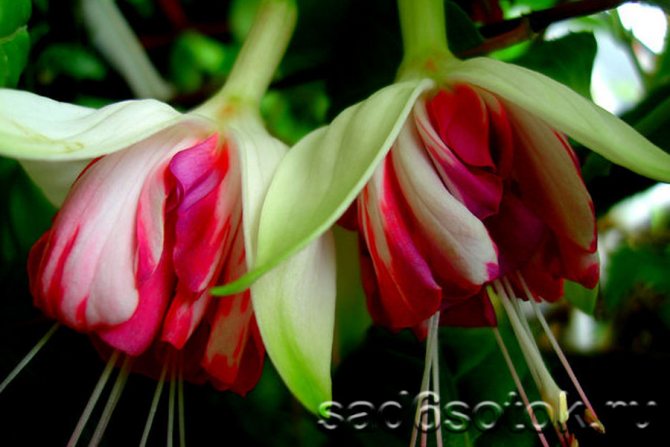

Fuchsia semi-ampel variety La Fiesta (La Fiesta)
Fuchsia loves porous, nutritious soils that absorb moisture well and allow air to pass through, a neutral or slightly acidic reaction. For self-production of high-quality soil mixture, one of the following recipes is suitable.
Option 1:
- 3 pieces of leafy land,
- 2 parts peat,
- 1 part sand.
Option 2:
- 1 part of turf land,
- 2 pieces of leafy land,
- 1 part humus
- 1 part sand.
In the case of growing in poorly nutritious soil, especially in the presence of an alkaline reaction, the plant will be affected by rot, will acquire a pale color of leaves, weaken flowering and can completely shed the buds... If possible, the soil is purchased in specialized stores.
Landing


Ornamental crops should not be planted in a pot that is too large. First, you need to pick up a small container, the diameter of which does not exceed 9 cm. Gradually, the roots will braid the space provided to them, and then they can be planted in a larger pot.
Before planting, it is necessary to prepare the medium for growing fuchsia. Flowers need fertile soil. Expanded clay or any other drainage material is placed at the bottom of the pot. Earth is poured over it. A plant is planted in it. The pot must be filled with soil so that there are no voids between the roots and the walls of the container. To prevent them from appearing, you need to shake the pot slightly and gently knock on it. In no case should you tamp the earth with your hands! The pores must be preserved in the soil.
Planting and transplanting
Planting fuchsia
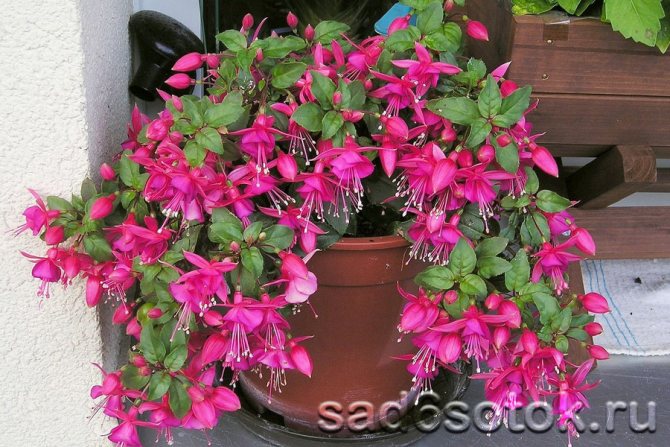

Planting and transplanting fuchsia
For planting, ceramic small pots are chosen, in which the substrate retains a stable temperature and optimal humidity longer. When planting cuttings ampel forms evenly spaced 3-5 pieces, which will give a lush beautiful bush with hanging shoots.
Bush forms planted in medium-sized pots, one plant at a time, so that the roots entangle the entire clod of earth in a season. In too large containers, the roots will rot, and in small containers, they will wrap up.
Drainage from expanded clay must be placed under the soil mixture layer. The soil is moistened, the plant is planted, spreading the roots and sprinkling with a loose mixture, and watering is carried out. After planting, the soil surface is best covered with peat, which will retain moisture and acidify the environment.
Fuchsia transplant
The transplant is performed in February-March, taking the bushes after winter storage from the basement. The earth is spilled with a weak solution of potassium permanganate, wait about an hour and, carefully holding it, remove the plant along with a lump of earth. If fuchsia developed normally and looks healthy, the soil is not shaken off, but is immediately planted by transferring it into the prepared mixture, using a pot with a diameter of 3-4 cm larger than the previous one.
Weakened bushes before planting, inspect, for which the ground is carefully shaken off, damaged roots and weak shoots are removed, if necessary, treated with foundation, and then planted.
Winter care
Preparations for the winter period begin in mid-autumn. To do this, gradually reduce watering, and also stop feeding into the soil. By the beginning of winter, the pot is moved to a cool place, the temperature in which is + 10 ... + 15 ° C. Indoor fuchsia feels comfortable in this temperature range. No lighting is required in this room. Watering is carried out every few months.
For the winter, fuchsia can be moved to a glazed (and necessarily insulated) balcony, if the temperature there does not drop below + 10 ° C. But, if you preferred this option, be aware: the plant will not fully fall into winter sleep, since the development processes will continue in the light. You will regularly need to water the flower, get rid of dry shoots and leaves, and, if necessary, treat it with an insecticide.
Another way to winter fuchsia is in the room. It has several disadvantages. The most important of them is that the plant loses its attractive appearance by the beginning of spring. To fix this, you need to prune the plant, as well as remove old shoots. In addition, you should move the fuchsia away from heaters.The plant should be sprayed regularly as the humidity level should be quite high. In this case, the room should be ventilated.
Care rules
Lighting and temperature


Fuchsia bush grade Andromeda (Andromeda)
Fuchsias are photophilous, but when exposed to direct sunlight, delicate leaves and buds get burned. Therefore, they are placed on the east or west windows, shading from the sun. A good option is to place it on a stand near the window; in this case, the south side is acceptable. When growing in the back of the room, additional lighting is used.
During the growing season, a temperature of 19–24 ° C is required; at lower or higher temperatures, the turgor of the leaves worsens, and the flowering becomes less abundant. In extreme heat, the shoots droop and require regular spraying.
Watering
A moisture-loving plant during the growing season needs regular watering and does not tolerate drought very well, losing leaves and buds. At the same time, the flower does not tolerate overflow at all, it is difficult to save such a plant - the leaves and shoots fall, and soon the whole bush dies.
The best way to avoid this is to water only as needed, wait until the ground is dry, and drain excess water from the sump. In hot weather, do not rush to water your pet, it is better to arrange a shower for her.
Top dressing
Any varieties are very responsive to feeding, which they begin to apply no earlier than a month after the spring transplant, and are carried out weekly. Use full-value mineral fertilizers for flowering species. During the period of development of seedlings and growth of the trunk, brands with a high nitrogen content can be used.
Fuchsia: care in the garden and at home
How to care for fuchsia


Fuchsia is classified as an unpretentious houseplant and is often grown in the garden or on the balcony in the summer. Indeed, the bloom of fuchsia is an impressive sight. Like a ballerina in a graceful skirt, she shows off her brilliant outfit. Against the background of rich green leaves, buds of white, pale pink, red or purple are revealed. Their long stamens with a pistil emerge from the cup-tube, decorated with a rim-skirt - this makes the flower look so much like a graceful dancer. You can admire the lovely dance from year to year, for this it is important to know what kind of fuchsia care is necessary and to follow these rules.
Fuchsia: careIllumination and temperature
The plant of mountain tropical forests - fuchsia, loves moderate temperatures, a lot of diffused light and humidity, and they must be provided first of all. The optimum temperature for it, even in summer, should not exceed + 20 + 22 °. At temperatures above + 25 °, the plant will begin to shed leaves and buds, and may even fade. Therefore, more often fuchsia is placed in partial shade, where the temperature is not so high. A lover of light, fuchsia does not tolerate direct sunlight, especially its varieties with light or dark purple flowers. From this it is better to place the plant on the north-east and north-west windows, and in the summer - on the balconies oriented in the same direction. Open air is an important factor in the successful flowering of fuchsia. Caring for this indoor plant involves moving it to a balcony or terrace in the summer. Increasingly, fuchsia is grown exclusively as a garden plant. In the open air, the "ballerina" is significantly transformed and prettier, the color of the flowers becomes juicier, and sometimes completely changes, the bushes reach unprecedented size and splendor. With the onset of warm days, a pot with a flower is put out on the street or dug into the ground. In the garden, the sophisticated "dancer" is given a well-lit place, protected from the direct sun and strong winds. An exception may be graceful fuchsia, less demanding on light and successfully blooming even in the shade. She will be able to grow on northern windowsills and in the most shady corners of the garden.Before moving outside, do not forget to harden the plant, taking it out for a short time beforehand.
We advise you to read:
EQUAL-LEAF BELL (CAMPANULA)ORCHID PHALENOPSISGRAPTOPETALUMWatering and spraying fuchsia
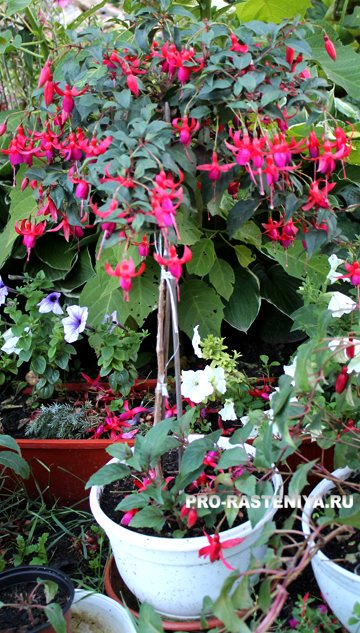

Plant care is also regular watering during growth and flowering. The soil should always be moist, but not swampy. Excess water in the pan must be drained; there must be drainage at the bottom of the pot. It is better to water the flowers in the morning; for this, use settled soft water at room temperature. Closer to autumn, watering is reduced, in winter they are carried out 1-2 times a month. Errors in care for fuchsia (improper watering) may be indicated by the following signs: • leaves, buds fall, flowers wither → the plant should be watered and sprayed more often; • wilting of the whole plant, dull color of leaves with well-moistened soil → excess moisture in the pot, decay of the roots, most likely the plant will die; • brown spots on the leaves → waterlogging of the soil, dangerous for the life of the flower, it is necessary to adjust the frequency of watering. But care will be complete when fuchsia takes a shower and frequent spraying - the plant retains in its genetic memory the growing conditions in the wild, where humid tropical air prevails. It is especially important to spray fuchsia in hot weather or at high temperatures in the apartment. Make sure that open sun rays do not fall on the plant at this time, otherwise water droplets can burn through delicate leaves and flowers.
Top dressing
Without such powerful helpers as fertilizers, a beautiful fuchsia cannot grow. Top dressing is an integral part of plant care. Fuchsia will be grateful for any concern about her nutrition. Long-term fertilizers are introduced into the pot along with the substrate during planting, strictly according to the instructions. Gradually splitting, they will deliver nutrients to the flower, and you will only have to water the ground. An alternative is instant fertilizers (full complex). They are applied immediately after watering from early spring to early September, 2 times a month, in summer, during budding and flowering, weekly. Soil top dressing can be alternated with foliar dressing, that is, with spraying the leaves. The concentration is followed according to the instructions. A ban on the application of soluble fertilizer are signs of disease in the plant and 2-week periods immediately after transplanting cuttings or fuchsia bushes. Outdoor care for fuchsia involves the use of
organic fertilizer
, eg,
ash
, mullein, humus.
Fuchsia wintering
Winter care should provide fuchsia rest. Only a rested plant will be able to fully grow and bloom next year. To do this, from mid-November (after the end of flowering), the temperature of the content is gradually reduced to + 6 + 14 °. At the beginning of December, fuchsia can be taken out on a heated loggia or placed on a cold window. The exception is the thermophilic species F. Boliviana, F. Microphylla and F. Triphylla hybrids. For them, the temperature must not be lowered below 15 °. If fuchsia grew in the garden, before the onset of frost and the temperature drops to + 7 °, it must be transferred to a cool, frost-free room with a temperature of at least + 5 °. The shoots are preliminarily cut by a third, the roots that have grown into the ground through the holes in the pot are shortened. Some frost-resistant varieties of Magelan and hybrid fuchsia in the southern regions are left in the garden in the ground under the cover of oak leaves and spruce branches. Previously, they cut off the branches, remove the leaves and buds. In cold climates, these fuchsias can winter in a basement without light. In this case, watering is reduced as much as possible, preventing the soil from drying out in the pot. If fuchsia is forced to spend the winter in an apartment with a normal air temperature, frequent airing of the room will do her good. You should only be afraid of direct drafts. At temperatures above + 18 °, fuchsia will shed its leaves.Flowering after such wintering will not be so plentiful.
Shaping, trimming, pinching
These are mandatory fuchsia care activities. Pruning is done in early spring or fall. Dry and weak shoots are removed, overgrowing tops are shortened by half or 1/3. It is advisable to carry out pruning in February-March, so that the buds can be laid by May. Pruning in April and later reduces the number of buds on fuchsia. Pruning ends the dormant period of the flower, now the air temperature can be gradually increased. With the help of pruning and pinching, they form a plant. Shrub fuchsias can be grown in the form of an erect or pyramidal bush, and in ampelous species, form long hanging shoots, or first create a lush crown, and let hanging shoots out of it. Formative nips begin to be carried out at the stage of growing cuttings. First, the top of the cuttings is pinched, then the resulting shoots, even later, the shoots that have grown from them, etc. Pinching is carried out every 2-3 internodes. It will take three years to get a flowering standard tree from a cuttings of bush fuchsia. When it is formed in the first two years, the main shoot is tied between two halves of a bamboo stick, and the lateral shoots appearing from the axillary buds are removed. When the height of the trunk is sufficient, they begin to form the crown. Leave 2-3 shoots and then pinch over each 2-3rd pair of leaves, pinch 3-4 times.
On video: Subtleties of fuchsia care
Transplant, soil and pots
Every spring, fuchsia is transplanted into a new larger pot, adding fresh substrate. They buy a ready-made earthen mixture for fuchsia or prepare it themselves from clay-turf soil (50%), peat (1/3) and sand or perlite (1/6). Drainage is placed at the bottom. To protect the soil from drying out, and the roots from overheating, choose white pots, or place an ordinary pot in a planter. The hydrogel added to the soil or sphagnum mulching will make it easier to care for fuchsia and help retain moisture. If fuchsia will be grown outdoors, choose volumetric pots. In an apartment, a pot with a diameter of 20 cm will be enough for her. In the garden, a pot of fuchsia can be dug into the ground. This will protect the plant from overheating and toppling over by the wind. Its upper part should protrude above ground level.
Features of care for fuchsia
• Remember the refined nature of the "ballerina": from the moment the first flower appears, the fuchsia pot must not be turned or put in another place, otherwise the plant may shed its buds. • After three years of cultivation, fuchsia blooms become less bright and lush. With the help of cuttings, new specimens are obtained, repeating the characteristics of the parent plant.
See more about the reproduction of fuchsia →
,
Fuchsia: description, legends. types and varieties →Diseases and pests
Fuchsia care can be difficult if the plant is infected with pests or diseases. Among them, the whitefly is more common,
aphid
,
spider mite
, powdery mildew, rust, gray rot. Methods of prevention and control of them are standard, applied to all indoor and garden plants. For example, the drug Aktara helps against pests and for their prevention, Fitosporin against fungal diseases. If you follow these simple rules of care, fuchsia will delight its owner with amazing flowering, creating an atmosphere of celebration, beauty and harmony in the house for many months.
Back to section
If the article seemed interesting to you, please vote for it by sharing it with your friends on your social network ↓
| <Previous | Next> |
Reproduction methods
Cuttings
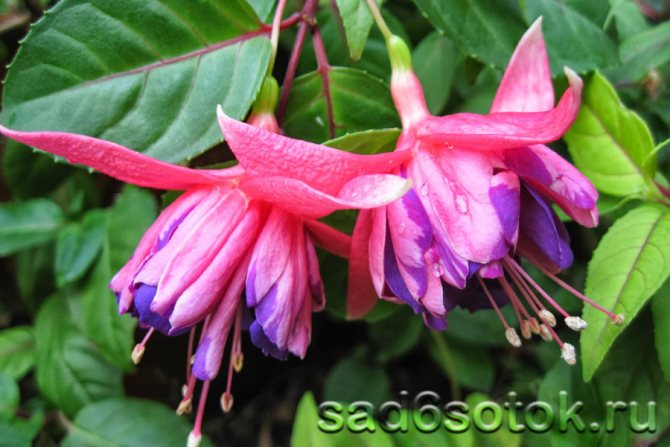

Fuchsia semi-ampelous grade Golden Monique
The most common and affordable way to reproduce fuchsias at home is grafting... Shoots with two or three internodes are used as cuttings.To prevent the cutting from fading and retaining moisture, large leaves are cut to half the size. Large healthy leaves, cut along with the adjacent bud, can also be used for propagation.
The prepared cuttings are treated with the Kornevin stimulator and planted in pots with a diameter of 5–7 cm, in a moist substrate, for the preparation of which up to half the volume of sand or vermiculite is added to the mixture for adult plants.
The seedlings are placed in a warm place with diffused light and a temperature of 18-22 ° C. To maintain air humidity, they are covered with cans or plastic bags. From time to time, the plants are sprayed, but do not forget to ventilate. In most cases, cuttings root easily with the yield of full-fledged seedlings up to 85-100%. After rooting, the plants are transferred to a permanent place and looked after as if they were mature shrubs.
Seed propagation
Seed reproduction also available to amateurs, the way to bring a new variety, if desired, is especially relevant. For this, the seeds are sown in small bowls with a small amount of sterile soil, lightly covered with vermiculite and covered with glass. Seedlings appear in 1.5–2 months, they are regularly watered by spraying and ventilated. When two true leaves appear, the seedlings are transplanted into pots and looked after as seedlings obtained by cuttings.
Growing, caring for and transplanting fuchsia at home (with photo and video)
Growing and caring for fuchsia at home is not difficult, since it is a plant that is undemanding to lighting and soil. It can be successfully cultivated even on large northern windows, but better on windows facing east or west.
In order to get blooming fuchsia in the autumn-winter period, until May it is stored in a basement at a temperature of 4–6 ° C or on a warmed veranda, then the shoots are pruned, the plants are transplanted, they carry out general care, removing the buds, and limit feeding in the summer. In the fall, they are brought into the room where it should bloom in the autumn-winter period. One of the features of growing fuchsia is choosing a place for the plant. Remember that this flower does not like sudden changes in place, so they immediately put it in a permanent place.
Fuchsia is transplanted at home in the spring before the start of growth, preferably in a small bowl, in a mixture of clay-sod and humus soil mixed with sand (3: 5: 1) or in a mixture of leaf, turf, humus and sand (1: 2: 1: 1).
You can add another part of the peat crumb so that the mixture is slightly acidic. When transplanting, it is necessary to cut the shoots by at least a third of their length.
The video "Growing and caring for fuchsia" shows all the main agricultural techniques:
Pests and diseases
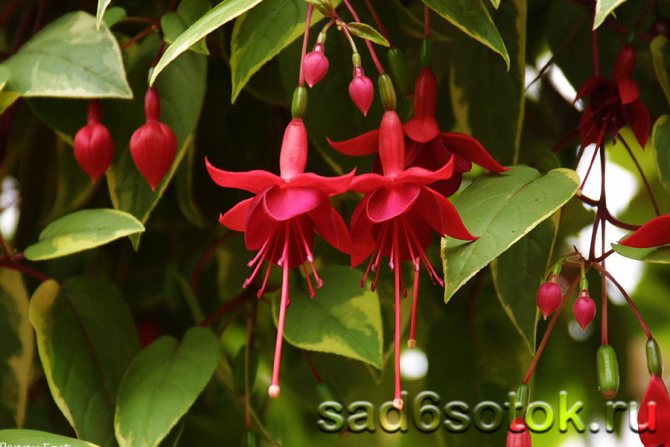

Fuchsia ampelous grade Golden Marinka
Succulent shoots and leaves are often affected whitefly, which, together with the larvae, sucks out the juice and is a carrier of viral infections. Vague yellowish spots appear on the leaf surface, the leaves themselves twist into tubes and later fall off. The insect does not like dry air, so the first thing to do is to stop spraying.
Defeat spider mite, another common pest, is noticeable in the form of whitish dots or the appearance of the finest cobwebs. The leaves dry out, the plant looks depressed and weak.
If a pest is suspected, the plants are examined by collecting or washing off the eggs and larvae of the whitefly and completely removing the leaves affected by the tick. Spraying with soapy water, sulfur suspension or Fitoverm and Dzhudo preparations helps well against the mite. In the fight against whitefly, the same means are used, in addition, you can put a cloth moistened with an insecticidal preparation (Aktellik, Decis, Aktara) on the ground and cover the bush with a bag for a day. Then the bag is removed and the room is ventilated.
A humid and warm environment encourages development gray rot, which is characterized by the appearance of dark spots of mold on shoots and leaves, which later die off. To combat the disease, moisture is reduced, diseased parts of the plant are removed, treatment with fungicides is used, of which Fundazol is effective.
The appearance on the underside of the leaf of small red-brown tubercles indicates a dangerous disease - rust... The affected parts, or better the entire diseased plant, are destroyed.
Whitefly can transmit mosaic virus, which in fuchsia causes the appearance of light mosaic spots on the leaves, their deformation, twisting and falling off. The mosaic treatment has not been developed, the plant should be destroyed.
To avoid the introduction of pests and viruses, all purchased seedlings and cuttings are carefully examined and quarantined for two weeks.
Trimming and pinching
Delicate beautiful buds appear on young peduncles. To increase their number, it is necessary to regularly cut the plant, forming its crown, and pinch young shoots. It is believed that a timely pinching is the key to the abundant flowering of the plant. In addition, by pruning, you can give the culture a well-groomed look. As you already understood, one of the features of the fuchsia plant is that it grows up to 3 meters in height. Considering that most often the culture is placed in houses and other premises, it becomes impractical to grow it to such a size. And at this moment cropping comes to the rescue.
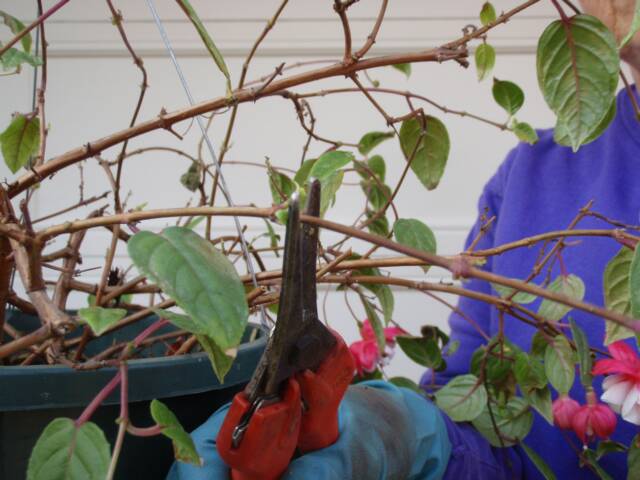

The procedure is carried out twice a year: at the beginning of winter, and also in October, after flowering. During autumn pruning, you should remove faded flowers so that the cut is 2 cm from the dormant buds. After a thorough examination of the plant, diseased branches, damaged shoots and old flower stalks are removed. If you find harmful insects, then the crop is treated with insecticides.
The second pruning takes place in January. It is at this time that the crown of the plant is formed. In the spring, you need to examine the plant again. If it was in a cool place in winter, then it will only be necessary to remove the spoiled shoots. If it hibernated in a room, then a third pruning is carried out using garden shears, removing weak branches.
Regular pruning is required in order for fuchsia to grow beautifully. A flower, the care of which involves pinching and shaping a bush, needs this procedure. The culture will not grow in height but in width. The main thing is not to spare old peduncles and stiff shoots, since they practically do not bloom, but they consume nutrients in full.
Winter care
In winter, fuchsias go through a dormant period, on which future flowering largely depends. For successful wintering, flowerpots are brought into the basement, loggia or cool veranda in November, stored at a temperature of 3-5 ° C. The pots should be buried in boxes with peat or sawdust, which will help not only insulate the roots, but also retain moisture.
Reduce watering gradually, starting in October, a sharp transition to winter maintenance can weaken the plant. Sufficient regularity of watering in winter is once every 7-10 days. If the flower is dormant in room conditions, the coolest place in the house is selected for it and watered moderately. At this time, it is important to prevent the soil from drying out.
How to properly water fuchsia in winter and summer
How to properly water fuchsia in winter and summer so that the plant blooms beautifully?
In the summer, fuchsia should be watered abundantly, sprayed and fed weekly with a solution of mineral fertilizers. With the onset of constant warm weather, fuchsias should be exposed to the air.
It is best to place them in a garden, in a slightly shaded area, or on balconies and outdoor windowsills that benefit from the full morning sun. In winter, watering of fuchsia is reduced, the plants are installed closer to the light, in a cooler room (from 5 to 12-14 ° C, depending on the species, variety).
In winter, fuchsias make a so-called haircut: they remove old branches, and the rest are slightly pruned to give the plant a more compact shape. Winter for fuchsia is a time of complete rest, so put it in a cool place, water less often (during this period, it is better not to water the plant, but spray it) and do not apply any fertilizers.
Fuchsia cultivation video
Unpretentious fuchsias attract with a variety of varieties and stunning colors of sophisticated flowers, each of which is unique. As soon as a lover buys one delightful bush, soon a whole fuchsia garden appears in the house, and the florist replenishes the army of fans of this ornamental plant, acquiring more and more new varieties. And this is not at all surprising, because it is impossible to resist the beauty and alluring novelty of this graceful flower dancer.
Fuchsia ampelous is not the name of a separate species, but a definition of a group of varieties. Ampels are plants with long, climbing stems that are grown for decorative purposes.
Ampel plants can be found in summer cottages, decorate gazebos or balconies. Fuchsia is an unpretentious plant that can be grown both on the balcony and in a home greenhouse or in a summer cottage.
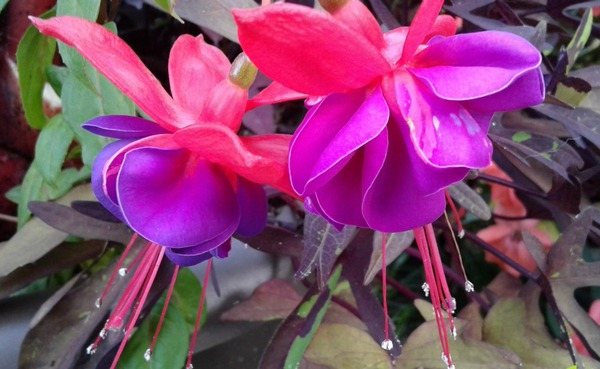

From the history
The "father" of fuchsia is considered French monk and botanist Charles Plumier (Charles Plumier), who discovered it on the island of Haiti in 1696-1697. His work on plants found in America was published in Paris in 1703. It was there that the name fuchsia, which he gave in honor of the famous German physician and botanist Leonart Fuchs (Leonhart Fuchs). The species that Plumier discovered is three-leaved fuchsia. Although in the English botanical journal in 1725 the plant is already mentioned under the name fuchsia, the British do not agree with the French authorship and believe that it was brought to them by their sailors.
Since the end of the 18th century, during the "feverish gathering of plants", new types of fuchsia began to arrive in England at the Kew Botanical Garden. Soon breeding work began in nurseries, for which fuchsia turned out to be a very grateful object. Already from 1835 to 1850, numerous hybrids and varieties were created in England, which were grown in houses and in the open field, where some of them overwintered.
In other European countries in the 19th century, fuchsia also found its fans. In Germany, the emphasis was placed on crosses with three-leaved fuchsia. And the famous French breeder Lemoine (Lemoine) has bred many varieties with large double flowers. After 1930, new fuchsias began to be created in the Botanical Garden of the University of California, USA. Now breeding is also carried out in the Netherlands, Australia and New Zealand.
It is believed that for more than 200 years of breeding, about 15,000 (!) Varieties and hybrids of fuchsia have been obtained. Currently, however, about 5000 are grown. In many countries there are associations of fuchsia lovers, uniting many fans of this wonderful plant.
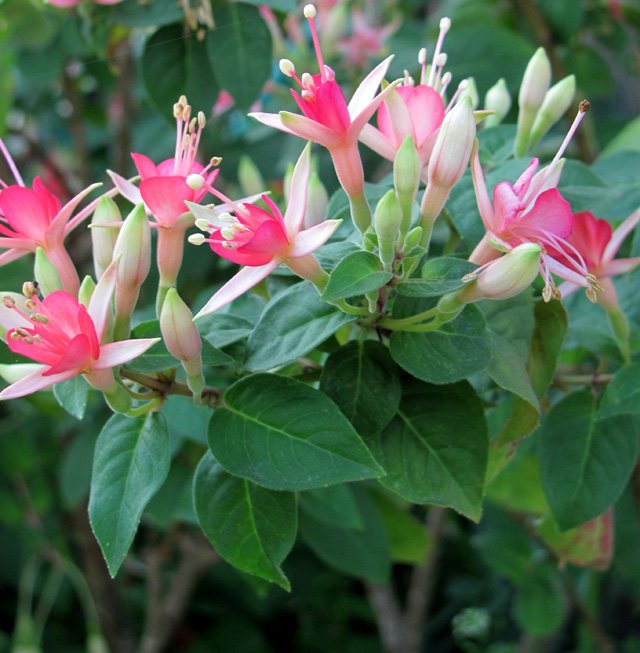

Some fuchsias have flowers pointing upwards. Photo by the author
Description of semi-ampel varieties
The peculiarity of semi-ample varieties is that they change their shape as they grow... At the beginning of their life, these are semi-shrub forms with fairly strong shoots, but with age, the stems become softer, and heavy flowers make them droop and hang down.
It should be noted that due to the weakness of the shoots, always it is advisable to tie the plant to a support (for a hanging planter, this can be a rope on which the structure is attached). With abundant flowering, it is important to remove faded flowers in time. It is also permissible to remove some of the buds so that the numerous flowers do not break the branches.
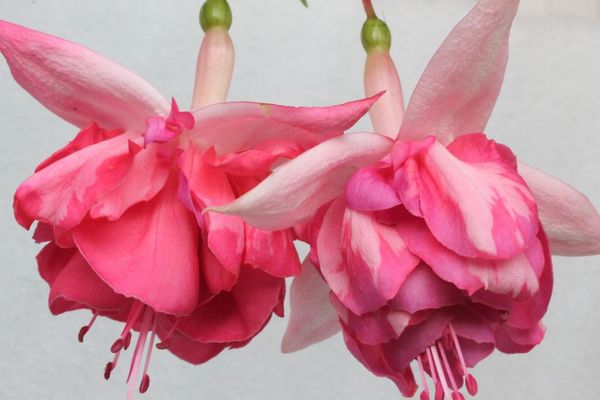

Fairy (fey)
Fairy is a very beautiful semi-charm variety. Flowers are bicolor - purple bud and white or red skirt. The contrast of red or white and purple creates an unusual look that will decorate a balcony or room.The stems do not hold well to the support, so it is best to grow as ampelous varieties. It is very important to remove excess flowers in time so that the stems do not break.
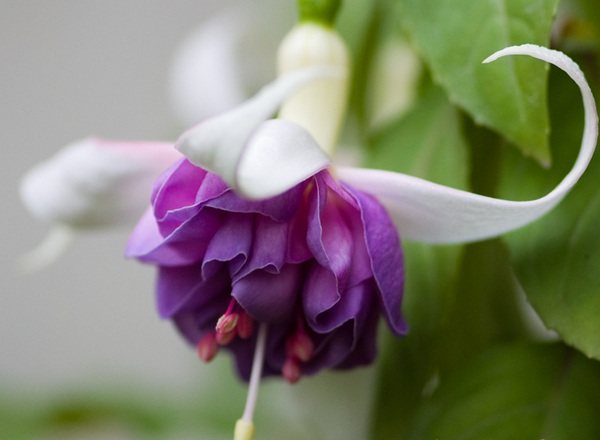

Golden Monique
The brightest representative of semi-ampelous varieties. Differs in large double pink flowers. The skirt of the flower is usually lighter in color than the sepals.
The leaves are golden in color, for which the variety got its name. With a lack of lighting, they turn green. The plant is very sensitive to sunlight, loves its abundance.


La fiesta
Unlike other plants of this variety, La Fiesta fuchsia has not a white skirt, but sepals. At the same time, the flower's skirt is bright crimson, very lush, decorated with white feathers. The variety is distinguished by abundant flowering and a large number of shoots... You can tie it up to shape a bush, but this is not always effective. It is advisable to ensure that the flowering is not too abundant, and the flowers do not break the shoots.
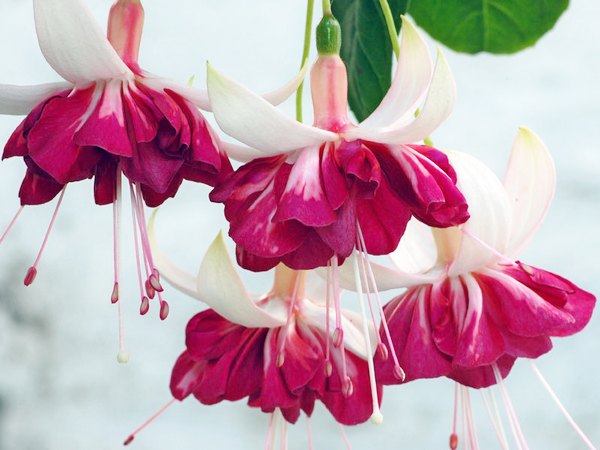

Cups and skirts
The most interesting thing about fuchsia is the flower. It consists of a cup and a rim, similar to a skirt. In hybrid fuchsias, these parts of the flower often have the most fantastic shape and color. Very small flowers may consist only of a brightly colored calyx, but this is rarely the case. Some fuchsias have 4-5 petals, which is why the flowers are medium-sized, and such varieties are called non-double. But the most spectacular fuchsias are with giant flowers, the corolla of which consists of numerous petals (such flowers are considered double). The petals themselves can be narrow and wide, long and short, small and large, which also affects the appearance of fuchsias.
Fuchsia flower structure. The light part is the calyx, the purple part is the corolla. Photo by the author
Surprisingly, the cup contributes to the decorative effect no less than the corolla. When the sepals are lowered down, the whole flower resembles an elegant earring, and if they are raised like wings, then a ballerina with raised arms. And of course, the unusual color combinations of the cup and petals give a special appeal to fuchsia. Most often, various combinations of red, purple, blue, magenta, pink and white are found.
Conditions for fuchsia
Fuchsia is considered one of the most unpretentious flowers, suitable for inexperienced growers. However, it should be remembered that she also has requirements for the conditions of detention.
Lighting and temperature
This is the most important condition - fuchsia needs a lot of sun. At the same time, the direct midday rays of the sun can be dangerous for leaves and young buds.


The ideal place is east or west windows, or south windows with a little shading. The "golden" varieties have an excellent marker - if the leaves lose their golden hue and turn bright green, then the plant lacks color. Greening of the leaves is normal in winter.
Pot size and soil
Fuchsia is not demanding on the ground, she a universal soil for flowers is suitable. In addition, the pot should be medium in size, preferably plastic. This will make the structure lighter, more comfortable and safe for the walls.
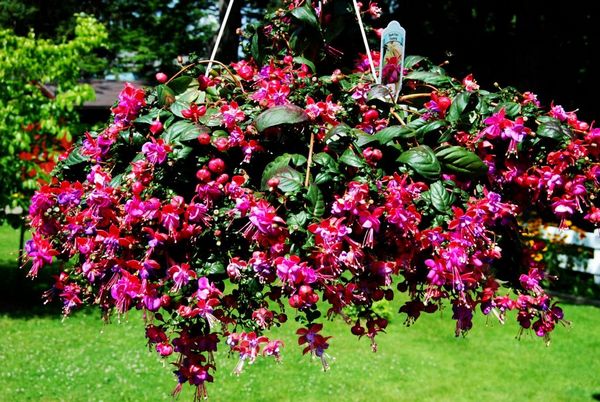

Watering and spraying
Fuchsia loves moisture, and its need to be watered every day. Every day you need to spray the flower, but this should be done in the absence of direct sunlight - in the evening after sunset or early in the morning. The best time to water is early in the morning.
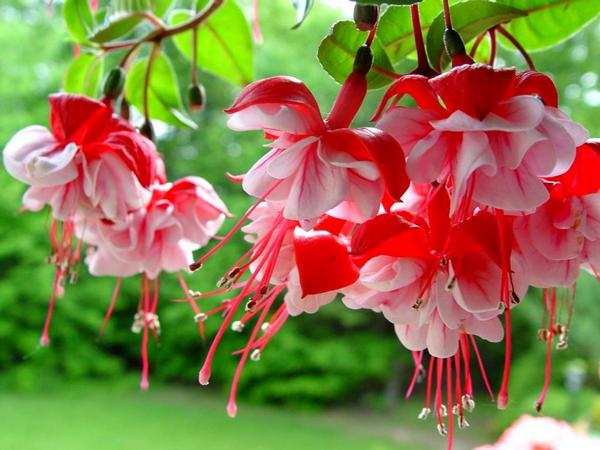

Pruning
Fuchsia branches profusely and new flowers appear in abundance. This can put a lot of stress on the root system, so you need to cut off excess shoots in time.


How to determine if shoots or blooms are or are redundant?
With too many shoots, fuchsia does not bloom well, some sprouts begin to dry out. Excess flowers break the shoots with their weight. If such signs appear, then it's time to cut off dry and excess shoots.


Fertilizer
Fuchsia easily responds to fertilizing and fertilization, so they need to be applied about once a week. It is not scary to miss the planned application of top dressing - the plant will be able to survive 2-3 days.
Too abundant feeding will also not be beneficial - the plant will begin to actively sprout branches that will overload the root system, and there will be few flowers.
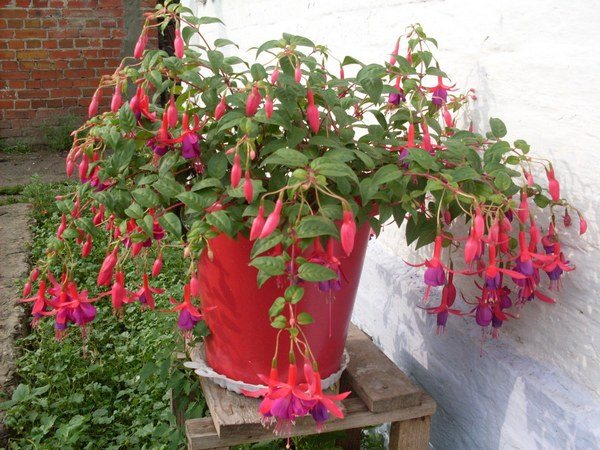

Transfer
It is necessary if the fuchsia roots are too overgrown, and they need a larger pot. This is done in late winter - early spring, the new pot should be 3-4 cm larger than the previous one.
The soil in a new pot must be treated with potassium permanganate an hour before transplanting. Fuchsia tolerates transplanting well, but you need to keep an earthen ball around the roots.
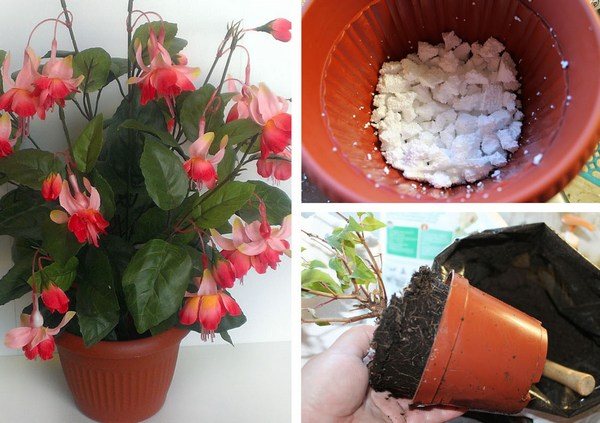

Hybrid and shiny fuchsia care at home (with photo)
Fuchsia hybrid (Fuchsia hybrida hort.), A family of fireweed. Derived from crossing several types of fuchsia. Most widespread. Its varieties differ in the size of the bush and leaves, the shape and color of the flowers, the duration of flowering.
Appearance and structure: small tree or shrub. Flexible branches are covered with opposite, medium-sized, green leaves, often falling off. Single flowers appear from the axils of the leaves, they are simple and double, of various colors. The flower consists of a corolla-shaped bright calyx and a tubular corolla with bent lobes.
As you can see in the photo, the stamens of the hybrid fuchsia are longer than the calyx:
Blooms for a long time. The whole bush is covered with slightly drooping, beautiful flowers. The fruit is a spherical berry.
Reproduction: herbaceous cuttings and large mature leaves with a strong petiole. The leaf is pulled from the stem with a sharp and precise movement. A bud grows at the base of the plucked petiole, which quickly develops into a young plant.
Features of the content: in the summer it is better to keep it on the balcony or in boxes on the outer window sill, where it grows continuously and blooms richly until late autumn, subject to abundant watering and regular feeding. When caring for hybrid fuchsia at home, flowering plants should not be moved and rearranged from place to place, as they can shed flowers and buds. Fuchsia is cut annually in early spring.
It hibernates at a rather low temperature - 6 - 8 C. During this period, the plant rests and needs more rare watering.
Annual specimens in the summer are useful to water with mineral fertilizers. Fuchsia is grown in pots in a mixture of greenhouse and leafy soil, peat and sand (1: 1: 1: 1/2). Suitable for decorating rooms with artificial light - greenhouses and winter gardens.
Fuchsia hybrid is used for growing in rooms and for gardening in the open field.
Fuchsia brilliant (F. Fulgens).
Homeland - Mexico. Medium-sized shrub up to 70–80 cm high, has a graceful columnar shape (the main shoots are directed vertically, the lateral ones deviate at an acute angle, forming a compact crown).
Leaves are opposite, pointed-elliptical to cordate-oval, large, up to 10 cm long, dark, with a reddish-purple tint, finely toothed.
Pay attention to the photo - in brilliant fuchsia, the flowers are deep orange-red to scarlet, drooping, elongated tubular, with a four-toothed, sharp limb, collected at the ends of the shoots in multi-flowered brushes:
Blooms from April to September. The fruits are edible. Easily molded onto a stem. Reaches the greatest decorative effect when landing in the summer in balcony boxes, containers or open ground.
It is a sun-loving species, has a powerful root system, therefore, it requires periodic transshipment of young specimens into a soil mixture with a high content of organic matter. In winter, keep at 5-7 ° C and moderate watering. In February-March, they form, shortening the shoots by a third of the length. With the onset of kidney development, the temperature rises to 15 ° C, gradually increasing watering. An increase in moisture contributes to better development.
Possible diseases and pests
The plant is affected by various diseases - gray rot, mosaic virus, rust. These infections are carried by insects and are transmitted by contact from plant to plant. Of the pests, fuchsia affects the whitefly and spider mite. A plant affected by a pest or disease need to be isolated from the rest and heal as quickly as possible.
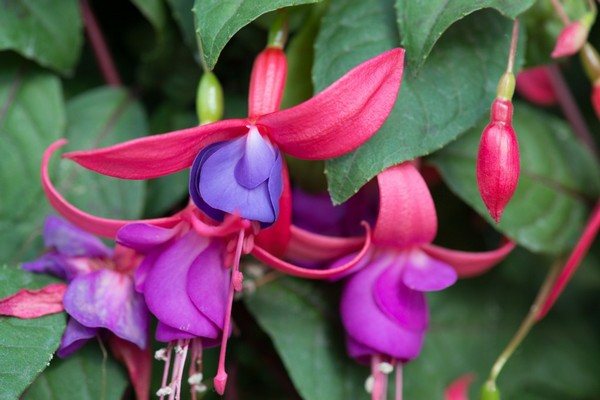

Problems
We talked about planting fuchsia in the ground and caring for the plant. Flowering can be low and abundant, and various diseases and pests are often the reason for this. If you properly care for the plant, then no problems should arise. But inexperienced growers sometimes make mistakes in caring for fuchsia, and this leads to the development of diseases.
If, for example, a flower has dropped its buds, then the problem lies in improper watering, moving the pot, lack of sunlight or lack of nutrients in the soil. If fuchsia sheds leaves, then this may indicate too high ambient temperature or lack of moisture. Waterlogging of the soil leads to yellowing of the leaves, and the appearance of black spots on them occurs due to unfavorable conditions during wintering or late nipping. If you correct the shortcomings in the care, then you can return the plant to a healthy look.
Do you know how fuchsia blooms with proper care and no pests? On strong peduncles, bright, but at the same time delicate flowers of different colors and shapes appear. But if pests settle on the plant, then flowering will be scarce and unattractive. Most often, fuchsia suffers from whitefly and spider mites.
Whitefly can be found by shaking the bush lightly. From it, insects, similar to moths, will fly in different directions, and larvae and eggs will remain on the leaf plates. And a spider mite can be found if you look under the leaves: they will be braided with a thin cobweb. Insecticides are used to control these insects, which can be purchased at any gardening store.
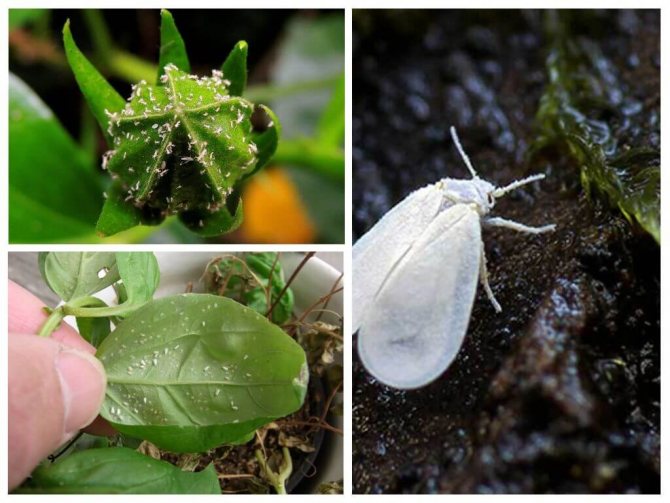

Thus, caring for fuchsia takes time and effort, but the result is a beautiful plant with lush flowering.
Reproduction methods
Like most plants, fuchsia reproduces in two main ways - vegetative and seed. It is better to take cuttings for propagation before pinching the plant.


Cuttings
Cuttings allow you to get a guaranteed result in a fairly short time. For cuttings, shoots and leaves with buds are used. Plants are kept at room temperature, watered regularly. Time for cuttings - early summer or late spring, but you can do this at any time, except for winter.
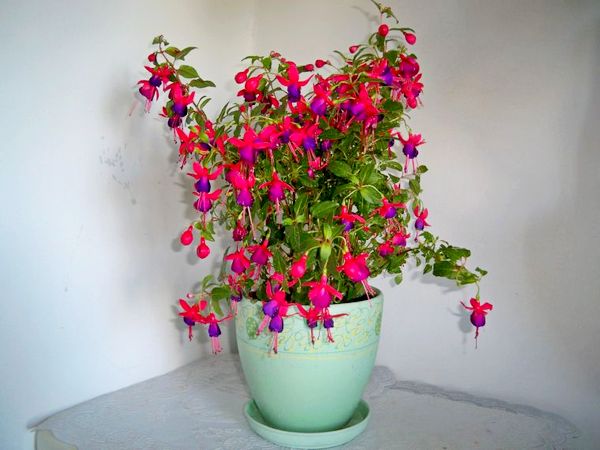

Seed propagation
The seeds can be purchased from a local grocery store or obtained from a blooming fuchsia. They are planted in small bowls, watered, treated with potassium permanganate. Seedlings appear in 1.5 months. After that, they are looked after as if they were cuttings.
Below are some helpful beginner tips for growing this flower:
Fuchsia Magellan
Indoor plant fuchsia magellanic is a tall evergreen shrub, the height of which reaches 3 meters. The leaves are small, their length is about 4 cm. They are covered with a barely noticeable downy. Beautiful scarlet flowers, sometimes growing singly, and sometimes gathering in inflorescences, attract the eye with their unusual appearance all spring and summer.
Fuchsia of this species tolerates low temperatures well. But, despite the fact that the flower can be left for the winter on a glazed balcony, it is still customary to bring it into the house, into a cool room. With the help of these colors, glass on the veranda, arches and shop windows are decorated.
Description of fuchsia garden perennial
Fuchsia owes its name to a German doctor L. von Fuchs, who is considered the "father of botany".
Fuchsia branches are distinguished by their flexibility, the aspiration of the crown downward.
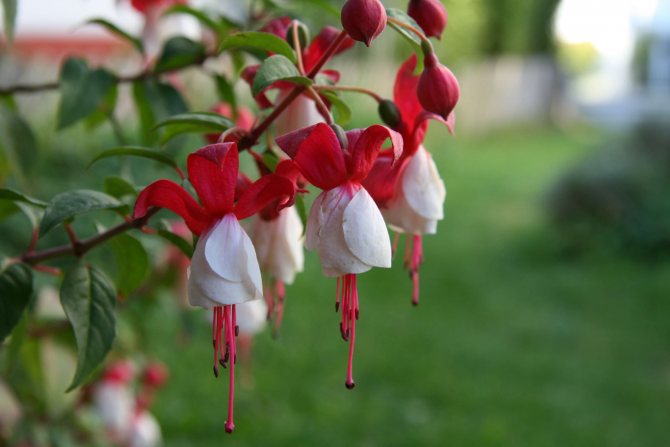

What does a flower look like
The leaves are bright green, oval in shape. Their length is about 5 cm. The ends are pointed, and the edges of the leaves have a serrated border. The stems are light reddish in color. Sometimes foliage also takes on this shade.
The flowers of the plant are single, directed downward. They are shaped like a bowl. Flowers are double, simple and semi-double. Their color varies: orange, lilac, cream, white, pink, blue and purple.
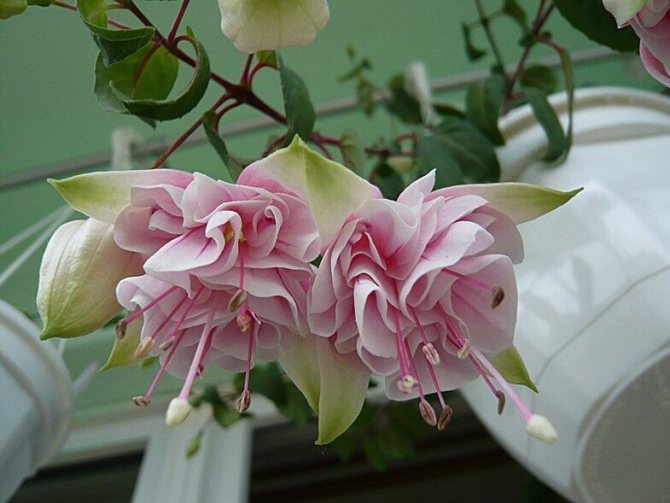

Terry flowers
Flowering continues for a long period of time. Flowers at this time more and more rush down and wither by the end of flowering.
Fuchsia is an annual or perennial plant
Fuchsia belongs to the genus of exotic perennial plants. But since this is a thermophilic flower, in northern latitudes it is one of the annuals.
The perfect combination
The universal color for combination is white. The combination of pale pink shades with dark colors also does not go out of fashion. Designers do not advise combining it with orange, it would be more appropriate to choose emerald, blue colors. The image becomes truly extraordinary when several shades of pink are combined.


It is he who is appropriate in everyday, formal and festive looks. The main thing is the harmony in the combination of colors, then even the most ardent admirers of fashion will envy you.
The main pests
As already mentioned, fuchsia is very often exposed to parasites and pests. One of these is the whitefly. In almost 50% of all cases, this parasite infects the plant if it is not treated with a special poison.
The whitefly is a very small, light colored fly. Its appearance is a bit like a moth, but its size is much smaller. As a rule, the parasite is removed from the lower part of the leaf, so it is not always possible to notice it without much viewing. When you shake the leaf, the midge takes off. These insects feed on fuchsia juice. They suck out all the water and nutrients from the plant. Subsequently, their effects, the leaves begin to turn yellow, and over time, a similar phenomenon passes to the stem. The main assistant in the elimination of the pest is "Akletik". If a parasite is found, it is necessary to spray fuchsia and repeat the procedure for 3 days.
With excessive moisture, powdery mildew fungus may appear on the leaves. Only 1 universal antifungal drug called Fundazol can fight it. Well, the last parasite is the red spider mite. It lives, like the whitefly, on the lower part of the leaf. At first, the surface of the leaf is covered with small white dots, after which it gradually loses its elasticity and slowly fades. Fitoverm is used to combat the red tick.
Fuchsia is an amazingly beautiful plant. Think 100 times before planting it in your garden, as it is very finicky and requires constant care.
How to grow: features of the procedure
The biological description of the plant is a compact small tree, on which there are reddish flexible shoots, medium-sized lanceolate leaves, numerous inflorescences of various shapes and colors. For growing in the garden, varieties with large and straight shoots are most often taken.
Each type of fuchsia has its own requirements for care and lighting, but a common feature is the fear of direct sunlight. You need to plant bushes in dark areas. The exception is the Aloha and Coral varieties, which retain their luxurious color even under the scorching sun, but require careful maintenance. Ampel bushes are preferable to grow in a garden in a pot or in a flowerpot.
Reference. When growing in garden, it is necessary to carefully monitor the condition of the bush, periodically renew the woody varieties for young ones.
Perfect neighbors for fuchsia in the garden are begonia, balsam or ivy.
Summing up
Fuchsia is a wonderful indoor plant that can be successfully grown in an open area.Ampelous varieties are incredibly beautiful, as well as tall fuchsias, which can decorate garden flowerpots, flower beds, and a porch area. Be sure to try both options for planting a flower, and you can enjoy its abundant magnificent blooms in the garden all summer long, and at home - outside the seasons!
Calla flowers are one of the most recognizable and elegant plants of the aroid species, capable of blooming in the home. In a special article, we will talk about which varieties are suitable for self-cultivation and what nuances of calla lilies care exist.
Possible diseases
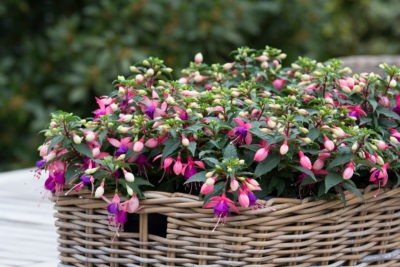

Garden fuchsia very often attracts pests, so you should be very careful about changes in the state of foliage and shoots. The most common diseases in this plant are:
- The appearance of brown spots or rust indicates a flower disease. Seeing such leaves, you need to remove them immediately so that the disease does not spread to healthy leaves. After that, you can process the flower with a drug like "Topaz".
- Yellow leaves indicate Chlorosis. This is a disease that occurs as a result of a lack of magnesium and nitrogen. It can be cured with fertilizers and less watering.
- Leaf loss can occur due to the whitefly, which feeds on flower juices, after which the leaves turn yellow. You can get rid of such pests by washing the plant with soap, and using special preparations like "Aktara".
- The spider mite gives out itself as a yellow-white bloom with dots on the back of the leaf. It is possible to treat plants from ticks with the help of "Fufanon".
Fuchsia growing in the garden can be subject to various diseases and pests. It is quite difficult to avoid this, given that pests can pass from other plants.
This is impossible to predict, and all that remains is to observe the state of the flower in order to prevent its death.
Fuchsia is a very beautiful flower that is suitable for the garden, both a beginner and an experienced gardener. It is quite easy to grow it based on recommendations and instructions. Sure, a flower in a pot requires less maintenance and worries than the one that is planted in the flowerbed (we talked about the secrets of growing fuchsia and caring for it at home and in the garden here). But this should not become an obstacle to planting this plant, because the flowering of unusual beauty will decorate any garden.
Fuchsia is quite capricious, although not too demanding in care. Achieving stable blooming of flowers and splendor of a bush is sometimes not as easy as it might seem at first glance. Read our resources on how and when to properly prune a plant, as well as how to transplant fuchsia and get abundant flowering.
Following actions
The basic rules of care are choosing the right place, watering and humidity. If the florist makes mistakes, the following signs indicate this:
- Leaves fall off and flowers wither - fuchsia does not get enough moisture.
- The whole bush wilts - there is an excess of moisture in the soil, the roots begin to rot.
- Brown spots appear on the foliage - regulation of the irrigation frequency is required, as the soil becomes waterlogged.
Plant care implies the obligatory application of organic fertilizers - mullein or humus of low concentration, ash. During the formation of buds and during the flowering period, the introduction of instant dressings is required.
On a note. It is necessary to carry out high-quality pruning of fuchsia. For this, dry or weakened shoots should be removed, and actively growing tops should be shortened by half.
Beige pink


It is another color that does not go out of style. He has different ideas about himself thanks to a variety of combinations. Warm colors suppress it, making it duller, while dark gray and purple colors make it more pink.
The beige-pink color gives a feminine touch and attracts attention. Both clothes and accessories in this color will always be appropriate.
Caring for garden fuchsia during flowering
Throughout the summer, you should carefully monitor the plant and immediately remove the wilted flowers, because as soon as seeds begin to form, the flowering will wane. Regular and very abundant watering and feeding are the main components of successful fuchsia cultivation. Fuchsia is a flower that tolerates well the so-called "long-term" fertilizers, so to simplify maintenance, you can safely choose a one-time feeding. For fuchsias, which do not like drying out of the soil, you can install automatic irrigation systems, and in the morning and in the evening you can carry out another moisturizing procedure - a warm shower.


Care features
Ampel fuchsia deservedly enjoys the love of flower growers not only for its attractive appearance, but also due to its unpretentious care in the garden, in a pots, in a flower bed or in a pot on a windowsill. After all, the cultivation of ampelous fuchsia can take place both in the shade in the garden and in an open space not protected from the sun, it does not put forward special requirements for the nutritional value of the soil and frequent watering, and you can get as much pleasure from its beauty as no other plant.
Watering and spraying
Rational watering is of great importance when growing fuchsia. How often to water this plant, how much liquid it needs, are influenced by various factors: the state of the weather, the type of flower, its location, stage of development, and even the size of the pot and the material from which it is made.
It is recommended to use settled or melt water for irrigation. Watering the flower is necessary in fairly moderate amounts. During active development, the soil should be slightly moist. In the summer, ampelous fuchsia can be sprinkled with rather cool water.
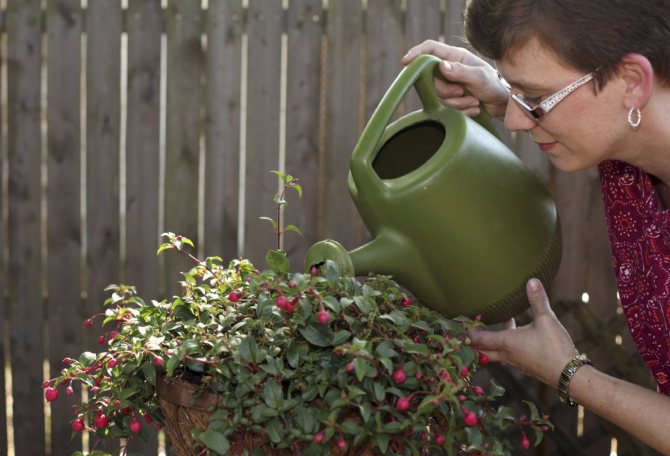

It is better to drain the excess water remaining after watering. From the end of autumn, it is enough to water the plant no more than once every two weeks. With the onset of frost, the plant can be practically not watered or it can be done very rarely.
Pruning
Fuchsia pruning must be done. It promotes the rejuvenation of the plant and the formation of the crown, prevents the process of exposing the stems. Pruning is carried out annually in the spring. Shoots are pruned one third of their length around the entire circumference of the flower in order to create a symmetrical plant.
Fertilizer
Fertilizing fuchsia is necessary for its better development. The fertilized plant is noticeable from a distance: it blooms unusually beautifully and develops magnificently. They usually begin to fertilize these plants as soon as the first flowers appear, and continue to do this while it actively blooms and develops. Top dressing is done approximately once a week with liquid complex fertilizers for plants in which it is necessary to control the nitrogen level. In winter, the flower does not need fertilizer.


Transfer
The transplanting process is also very necessary for fuchsia for its formation, because with the new soil all the necessary trace elements and nutrients are supplied to it. Young plants are transplanted once a year, older ones are enough to transplant once every three years.
The transshipment method is optimal for transplanting fuchsia: it is carefully transshipped, preserving the integrity of the old soil with the root system, and fresh earthen mixture is added to the free space of the pot, preventing the formation of a void between the root system of the flower and the walls of the pot. After that, the plant must be watered and left to adapt. In no case should you forget about the drainage layer.
Conditions
delivery on April 21 *, Friday
- Nearest pickup on April 21 * , friday
- RUB 400 for orders from 600 to 3000 rubles.
- For orders over RUB 3000 delivery as a gift.
- Orders less than 600 rubles.(excluding shipping costs) we do not deliver by courier.
* For orders placed before Wednesday 3pm
Attention! From 12/14/17 to 01/07/18 we work only in the mode of receiving orders.
Delivery across Russia
Geography of orders, delivery time by Russian Post, price. Details of delivery by Russian Post >>
Delivery by courier in Moscow
Ways of payment
- Cash to the courier or the administrator of the pick-up point
- Transfer to a Sberbank card
- Wire transfer
Pickup in Moscow
Attention! You can come to pick up your order after preliminary confirmation of the date and time of self-pickup.
Point of issue metro Profsoyuznaya
Address: m. Profsoyuznaya, st. Vavilova, 66, Triumfalny shopping center.
- The cost is 50 rubles.
- Office hours: from 12:00 to 20:00 Mon-Fri, from 12:00 to 19:00 Sat-Sun
Meeting in the metro
- Wednesdays and Sundays at 13:00
- Is free.
Delivery by Mail in Russia
- Cost: Package – RUB 350, Package 1 cl. – RUB 500 (including packaging).
- The postage period is from April to October.
Attention! Plants are dispatched by mail within 7 days after confirmation of order payment.
Delivery in the Moscow region
Delivery of orders in the Moscow region is carried out by agreement. Contact us to find out about the possibility of delivery to your address in the Moscow region.
Cold pale pink


A shade for all occasions, its versatility, romance make it possible to replace white in your everyday or formal look.
Cool colors are an ideal complement to this shade. Combinations of pale pink gray or black colors are more suitable for a classic look.
Flower - ballerina
Luxurious flowering, a variety of varieties and shapes, unpretentiousness and plasticity - this is why flower growers all over the world love fuchsias so much. They can be grown at home and on the street, they can be formed into beautiful bushes, standard trees or "waterfalls" running down from hanging baskets or balcony boxes. And although fuchsias do not hibernate in open ground in Russia, since they only tolerate small frosts, they are still real perennial plants that do not cause unnecessary trouble in growing and reproducing. It is worth getting at least one fuchsia, and every year you can admire its many bright flowers, similar to ballerinas in fluffy skirts.
Cups and skirts
The most interesting thing about fuchsia is the flower (see photo). It consists of a cup and a rim, similar to a skirt. In hybrid fuchsias, these parts of the flower often have the most fantastic shape and color. Very small flowers may consist only of a brightly colored calyx, but this is rarely the case. Some fuchsias have 4-5 petals, which is why the flowers are medium-sized, and such varieties are called non-double. But the most spectacular fuchsias are with giant flowers, the corolla of which consists of numerous petals (such flowers are considered double). The petals themselves can be narrow and wide, long and short, small and large, which also affects the appearance of fuchsias.
Surprisingly, the cup contributes to the decorative effect no less than the corolla. When the sepals are lowered down, the whole flower resembles an elegant earring, and if they are raised like wings, then a ballerina with raised arms. And of course, the extraordinary color combinations of the cup and petals give a special appeal to fuchsia. Most often, various combinations of red, purple, blue, magenta, pink and white are found.
Reference. The genus fuchsia (Fuchsia) belongs to the Cypriot family, i.e., in addition to our well-known ivan tea (fireweed). More than 100 species of fuchsia are known - perennials, shrubs or small trees growing in the subtropical and tropical zones of Central and South America, as well as on the islands from New Zealand to Tahiti. In culture, f. three-leafed (F. triphylla) and f. hybrid (F.x hybrida).


Three-leafed fuchsia is a plant up to 60 cm high with straight semi-woody stems growing from the rhizome, and large leaves with a dark burgundy underside. She has graceful, tubular, bright coral flowers 5-6 cm long, collected in a short raceme.Varieties with its participation are allocated in a separate group, but there are much less of them than hybrid fuchsia.
F. hybrid obtained as a result of numerous crosses with the participation of F. fiery red (F. coccinea). f. sparkling (F. fulgens), f. magellanic (F. magellanica) and other species. The bush can be upright, spreading and ampelnous in shape (creeping or falling down) and have a height of 30 to 70 cm.In most varieties, the flowers hang down, but the bushes in which they are collected in small inflorescences and look upward look no less elegant.
How does fuchsia breed?
Fuchsia can be propagated in two ways: by seed or vegetative. Both options are considered to be working and effective for producing mature flowering plants. Let's talk about each in more detail.
Seeds
As is most often the case with ornamental flowering crops, seed propagation is more laborious and leaves the risk of getting a plant that does not have the characteristics expected.
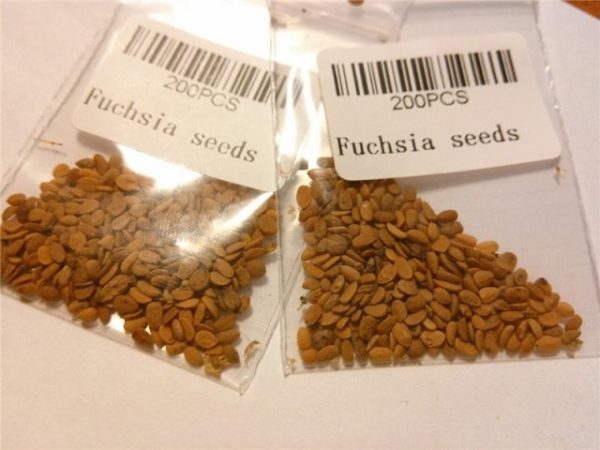

Fuchsia seeds
The fact is that most modern fuchsias are hybrids, and during seed cultivation, the properties of the mother plant are lost. But, some gardeners believe that fuchsia grown from fuchsia seeds are stronger, so they use this method.
To grow fuchsia using this method, it is better to purchase seeds from a gardening store, choosing the desired variety. The seeds are sown at the end of March, it is better to immediately plant them in peat tablets or pots, so as not to dive and transplant directly with the substrate, without injuring the roots.


Three weeks of planting are kept at a temperature of 16-17 degrees, moistening the peat and waiting for the first shoots. Then young fuchsias can be transferred to the windowsill and observe room temperature before planting.
Vegetatively
As a rule, cuttings are used for vegetative propagation. In a healthy, flowering and strong bush, part of the shoots is cut off, which are then rooted.
Table 2. Step-by-step instructions for cutting fuchsia
| Illustration | Description |
| Step one: 10-12 centimeters long shoots are cut from the mother plant. You need to cut off the cuttings with two or three knots of sheets. You can take shoots from a houseplant. |
| Step two: powder the tip of the cutting with a powder that stimulates root growth (like Kornevin. |
| Step three: fill a small pot or even a plastic cup with garden soil (any universal will do). |
| Step four: Stick the stalk a few centimeters into the soil, then water liberally. The pot with the future sprout should be placed on the windowsill, where there is a lot of light. |
| Step five: keep an eye on the moisture content of the cutting - it needs to be sprayed daily from a spray bottle. |
Video - Reproduction of fuchsia by cuttings
Outdoor temperature
An increase in air temperature indicators of more than 25 ° C for the normal growth of fuchsia and the formation of buds should not be. High temperatures are dangerous because the leaves and flowers will begin to wither, and the plant will discard them altogether. The risk of developing diseases also increases.
The minimum temperature threshold is 5-8 ° C. In the cold season, flower development is suspended until warmth.
Fuchsia is a garden flowering plant, unpretentious, but it will have to pay some attention, saving it from the scorching rays of the sun and lack of moisture in summer. It is important not to forget that fuchsia is one of the exotic plants intended for cultivation in an area with a warm climate. In winter, flowers growing in the garden must be covered so that they do not die. Be sure to temper the fuchsia before returning to the fresh air. Flowers respond well to feeding, delighting gardeners with their bright and rich colors and lush shapes.
Planting instructions
The easiest way to grow is to plant the fuchsia in a pot or hanging basket that will weigh on the veranda.This type of planting is not so problematic, because with the onset of frost, the flower can simply be brought into the house and not transplanted again. For experienced gardeners, it will not be difficult to plant a plant in a flower bed, but in this case, you need to think carefully about the planting site.
Fertilizer
It does not matter where in the garden the flower will be located in a basket or in a flower bed, the composition of the soil and fertilizers is of great importance... Before planting, it is necessary to apply a sufficient amount of humus and phosphorus fertilizers.
During flowering, you should also not forget about fertilization, as the flowers will quickly wither. Each plant must be fertilized from the moment of planting.
For fuchsia, the type of fertilizer can be distributed according to the growth phases:
- Young plants need a complex fertilizer that contains a large amount of nitrogen. This component of the fertilizer helps to accelerate plant growth and plant greenery.


For a grown flower, fertilizers with a high content of potassium and phosphorus are best suited, which will help the plant to lay a large number of buds for flowering.
A good option for fertilization would be if you alternate mineral with organic... It should be remembered that high-quality fertilizers increase the decorative properties of the plant.
You should not fertilize the plant 2-3 weeks after transplanting (you can find out how to correctly transplant fuchsia and get abundant flowering here).
Reproduction
This plant has several methods of reproduction, including:
- Seed reproduction: in order to get seed fuchsia, gardeners resort to artificial pollination. Gardeners like this type of reproduction, because by mixing several different varieties of plants, you can get a completely new one that is not like the rest. Seeds must be collected in dry and warm weather, and after harvesting, the material must be dried.
- Using cuttings: reproduction in this way must be done in March. For this, cuttings with a length of 5 centimeters or more are suitable. Usually they are previously placed in water for rooting, after which, three weeks later, they are planted in a pot consisting of fertilizers and sand.
- With the help of leaves: This method is one of the longest. For this species, stalks with several leaves are chosen and carefully torn from the plant, after which, without germinating the roots, they are placed in loose soil 1 centimeter deep and covered with a lid.
A plastic or glass lid works best. For successful germination, the leaves must be watered daily, sprinkling with boiled water. The plant will be ready for transplanting as soon as the roots appear.
Each type of germination is interesting in its own way, but the most common is growing with cuttings. This method is most effective for inexperienced gardeners.
The seed material for germination is obtained exclusively from ripe flowers.
Some nuances
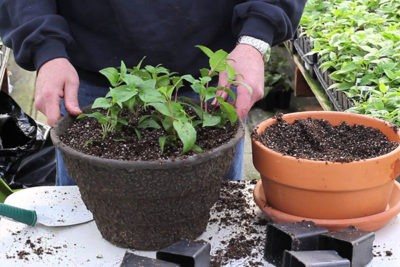

You can grow fuchsia in the garden, but for this you need to spend time and be prepared for the fact that the plant does not take root. In order for the plant to take root in the flower bed, the following rules should be remembered:
- For planting, a plant is used that has already been growing in a pot for some time. You should not use recently sprouted flowers, they may not take root in the new soil.
- The landing site should be chosen carefully, without direct sunlight and drafts.
- No other flowers should grow near the chosen place, then one of the plants may die.
- It is only necessary to plant fuchsia in pre-fertilized soil and remember about feeding during the release of flowers.
Using such simple rules when planting a plant, you can achieve a good result. Then the plant will grow and release many new buds, while delighting the gardener.
Types and varieties of fuchsia photo
When growing fuchsias at home, about 2000 hybrid varieties are usually used, including erect shrubs, dwarf shrubs, ampelous, dwarf and standard plants. It is in hybrids that the corolla and calyx have the greatest number of color combinations, as well as a variety of types of flowers - double, semi-double or simple, large or small.
Large-flowered hybrid varieties of indoor fuchsias are often united by a common name for them - beautiful fuchsia, or beautiful, is the result of crossing shiny and sparkling fuchsia.
Among the small-flowered fuchsias, the following groups are most often found:
- F. three-leafed - a hybrid, which is a short, well-branched bush. Ovate oblong leaves are very decorative in color: on top they have a reddish tint, and below they are brownish-red. flowers are long and narrow, bell-shaped, painted most often in bright red and orange tones. This species blooms from May to October. Looks good in hanging pots.
- F. Magellan, suitable for large rooms, as well as for open ground, since it can reach 3 meters in height. The leaves are medium-sized, the flowers are axillary. Tolerates frost if cut and covered securely.
- F. recumbent - the ancestor of ampelous hybrids and varieties. Small flowers, unlike many relatives, are directed upwards. It can also be grown in standard form, but is more often used for grafting on stems.
- F. brilliant (sparkling) - an evergreen bush, branches are lignified, in the lower part they often acquire a reddish-brown tint. Blooms profusely from June to October, fruits are edible.
- F. graceful, with shoots looking down. The flowers seem to float on threadlike, very thin pedicels. Their corolla is usually reddish-purple, the calyx is colored red or pink, and the pistil and stamens are bright red.
- F. Bolivia is distinguished by abundant early flowering - from March or April. Inflorescences reach a length of 30 centimeters. She needs warm rooms.
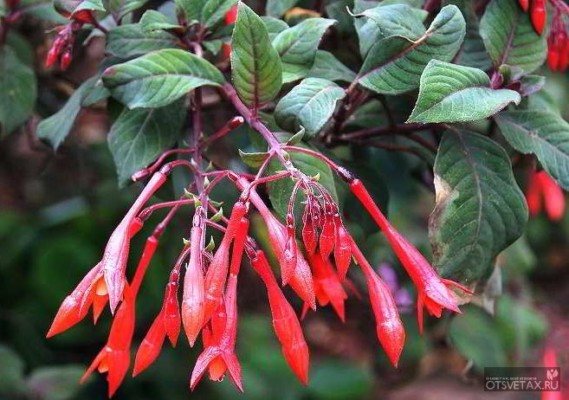

f. triphylla (f. tryohlistnaya)


f. magellanica
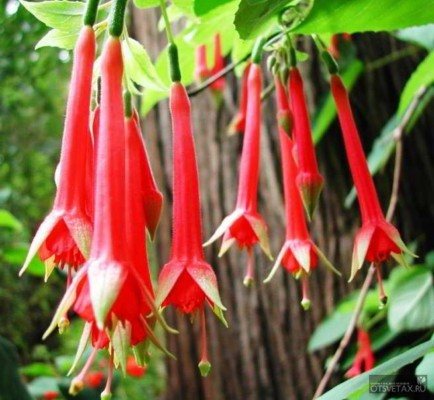

f. fulgens (f. blestyashhaya)


f. boliviana
It is simply impossible to list hybrid fuchsia varieties intended for indoor cultivation - there are more than two thousand of them, each more beautiful and elegant than the other.
The most common varieties of hybrid fuchsia are:
- "Alfred de Groot", erect, mauve petals-skirt and delicate pink sepals;
- "Annabel" - bush and ampelous, her flowers are large, double, with a white "skirt" and sepals, painted from white to pale pink;
- "Ballerina" is an erect plant with scarlet sepals and a lush white or pale pink "skirt";
- "Cecile" is an erect bush with dense double flowers, delicate red sepals, in a bluish-lilac "skirt" with a wavy edge;
- "Marinka" - ampelous fuchsia, its bright red flowers are simple, but always in huge quantities;
- “Prince of Peace is an ampelous variety with simple flowers, very decoratively colored - a bright red or lilac corolla-skirt with white sepals;
- "Santa Clara" - also an ampelous variety, large, double flowers, cherry-colored "skirt" with white transitions and white sepals;
- "Voodoo" - erect, large double flowers, "skirt" has a dark blue-violet color, and sepals - bright red.
What to do with fuchsia in winter?
Fuchsia is not able to survive serious frosts in the soil, therefore, in regions with a "real" winter, plants are sent for wintering. Before the first cold weather, the bushes are cut in half, carefully dug out, preserving the roots, and transferred to containers, placing them close to each other (the soil on the roots should be preserved).
To prevent fuchsias from growing in a container, they are kept in a moderate temperature (about 10-12 degrees). Once every two weeks, it is worth spraying the earthen comas on the roots so that they do not dry out. Fuchsia light is not required during hibernation.
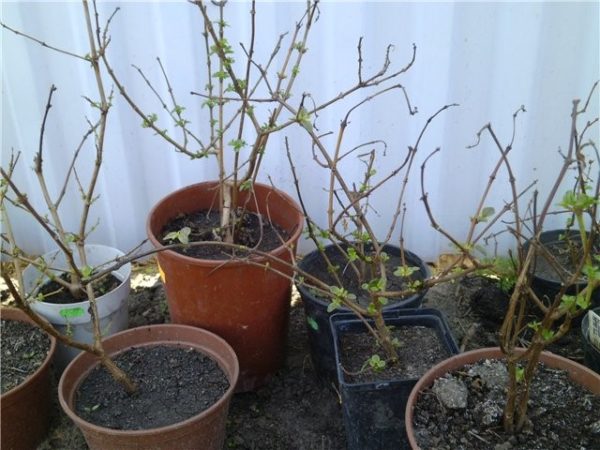

Fuchsia is not dug from street flowerpots
Plants need to be brought back to life around March. To do this, with a sharp pruner, you need to cut off all shoots up to 10-15 centimeters, transplant them into nutritious fresh soil and gradually increase the intensity of watering. With the onset of warmth, the culture is planted again in the old place in the garden.
Is wintering on the street permissible?
Some varieties of fuchsia, for example, "Magellan", winter well under the snow, provided that the gardener has made an effort to insulate. Therefore, if you decide that your fuchsia will overwinter under the snow, you need to carry out the following work:
Cut off bushes and shoots at ground level.
Sprinkle with a 20 cm layer of earth, cover with spruce branches, and on top - with a waterproof material.
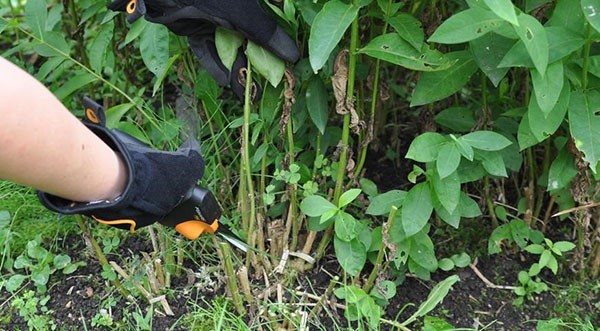

Pruning
In mid-May, the plant is gradually opened, first removing the top layer, then removing the spruce branches and the soil layer. After a month, fuchsia will begin to wake up and give the first shoots. But, this method can provoke a stop of flowering, so if you want to see bright fuchsia flowers every season, it is better to winter the culture in a warm place.
Fuchsia transplant
Fuchsia is usually transplanted once a year, in March, before the first buds appear. It is best to choose a container with thick walls for it, for example, a ceramic one. The pot is taken two to three centimeters in diameter larger than the previous one, but no more. Too large a pot will cause the plant to grow root and green mass, but it will flower less well.
Important! At the bottom of the fuchsia container, it is imperative to lay out drainage so that the roots do not absorb too much water.
A small amount of fresh soil mixture is poured onto the drainage, the plant is rolled from an old pot to a new one along with a lump of soil. The remaining free space is also filled with fresh soil mixture.
Before transplanting, all fuchsia shoots must be shortened by a third. During transplantation, it is necessary to carefully examine the roots and remove damaged, diseased or with signs of rot. Healthy plant roots are white.
Photo gallery of views
When you can take fuchsia outside
Fuchsia loves warmth, but does not tolerate heat. You can take it outside with the onset of summer heat. The temperature should be approximately 20 ° C. Moderate temperatures, humidity and ambient light are the key to proper cultivation and outdoor care for fuchsia.
Fuchsia in the garden is either transplanted into the ground, or remains standing in the pot. A place is chosen that is sufficiently illuminated, with protection from direct sun and strong winds.
Important! Before taking the fuchsia outside in the summer, it is important not to forget to temper it. To do this, it is periodically taken out to fresh air for a short time.
Fuchsia - the flower of creativity
For a burst of energy and elimination of "creative crises", artists, architects, poets and other people with a creative direction are presented with fuchsia for the holidays.


The plant gives you peace of mind, fills your thoughts with creative ideas and gives you the opportunity to complete non-standard projects. The fuchsia flower located in the house prevents residents from diseases of the gastrointestinal tract, stabilizes the work of hormones and glands.
The plant will not harm people who take good care of the flower and do not forget about caring for it. In a house where there are children, fuchsia will help to quickly find a common language between parents and children, help to find mutual understanding between them.
It is also believed that by loving and caring for your beauty, you will receive in return love, multiplied several times, which can fill you with charm and charm. If you suddenly dreamed of fuchsia, expect a change for the better in your personal life. Soon you will have a loved one who will bring a lot of pleasant emotions. If in a dream there are other people besides you, then expect a grandiose holiday. For example, a wedding.
And if you dream of fuchsia and there are animals, wait for a meeting with old friends. Fuchsia is a diverse ancient plant that has several types of existence - a tree, a shrub, a flower. This flower can serve as an excellent gift for the holidays, decorate your home or garden, create coziness. The main thing is that for every person there is a kind of flower that will give spiritual harmony.
Fuchsia - growing problems
The wintering of fuchsias presents a lot of problems. In the cold period, the plants are transferred to a cool room, at temperatures above 15 ° C and poor lighting, it is strongly stretched. If there is no suitable room, then you will have to create artificial lighting of the bushes with fluorescent lamps. Constant flowering leads to exhaustion, so a cool wintering on the loggias is the best option.
In the matter of how to make fuchsia bloom at home, Zircon helps perfectly, this fertilizer causes the appearance of buds even in the most picky varieties. The beginning of the laying of inflorescences is the most important period, at this time it is undesirable to twist the pots around the axis, rearrange them to a new place. In the heat, the plant often sheds its leaves; you can lower the temperature with air conditioning or by spraying green mass. If harmful insects appear in summer, use Aktara or other insecticides.


Why does fuchsia not bloom
What to do in such cases? Where to look for the reason? The reason most often lies in improper care. This may be excess moisture, in which the roots rot. In this case, you need to adjust the watering. Fuchsia will not give flowers even if it lacks light. Since she is painful to permutations, you need to initially take care of sufficient lighting. If the flower is located near the north window, you can only help here with additional light sources.
If the plant lacks trace elements, it will also respond with a lack of flowering. But it is necessary to remember that an excess of nitrogen also leads to this. Therefore, top dressing must be strictly balanced. During the winter, the temperature for fuchsia was not provided - it was too hot. In this case, you can help by carefully moving it to a room with a low temperature for several days.
Too large a pot is a common cause of lack of flowers. When the roots have an excess of space, they grow first, then the leaves. All the plant's strength is spent on this. There is only one way out - to transplant fuchsia into a tighter container.
Home fuchsia care rules
It is believed that growing fuchsia at home is within the power of even a novice florist. This is true, since the rules are simple, and the plant itself is striking in its vitality.
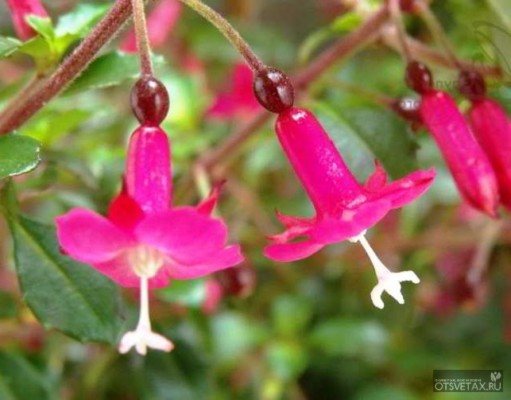

f. microphylla (f. melkolistnaya)
Location and lighting
Heat-loving fuchsia is prone to good lighting. Therefore, the place for it must be chosen on the windowsills positioned on the sunny side - west and east. South-facing windows are also suitable, but it would be better to place the plant not on the windowsill, but on the counter next to the window.
In any case, in the summer, fuchsias need to be shaded a little, since this is a forest plant, and direct sunlight is harmful to it. For shading, it will be enough to tighten the glass with ordinary plastic wrap - to create the effect of frosted glass.
Important! It is necessary to prepare shading in advance, since during flowering fuchsia can neither be moved nor rotated. Otherwise, she will drop all flowers and buds.
If fuchsia lacks light, its shoots will stretch excessively, which will negatively affect both the condition of the plant and its appearance.
Temperature and humidity
During the period of active growth and flowering, fuchsia needs warmth. She will be satisfied with a temperature of up to a maximum of 26 ° C, exceeding this indicator is undesirable, since it can begin to fade and shed flowers. In winter, fuchsia is suitable for temperatures from 16 to 20˚С.Sometimes they even move her to rooms with a temperature of 10-12 ° C so that she can have a good rest.
Important! Fuchsia must be protected from drafts at any time of the year.
An acceptable level of air humidity for fuchsia is from 40 to 60%. And if exceeding the desired level for some time is permissible, then too dry air will cause wilting of leaves and drying of pedicels. Therefore, in hot weather, fuchsia should be sprayed with soft water at least 2 times a day, and even better - put a wide-necked container of water next to it.
In winter, the high moisture content of fuchsia is needed, and even harmful, so no additional measures to moisturize the plant need to be taken.
Watering rules
Watering during the active growth of fuchsia and its flowering should be abundant. It is carried out as the top layer of the soil dries up. To avoid problems with the roots, excess water must be drained immediately. During the rest period (winter), fuchsia is watered less often - once every 5-6 days. In October-November, you can water less often.
Important! For watering fuchsia, soft, well-settled water is required, since it does not tolerate acidification or, conversely, soil salinity.
Fuchsia substrate and its feeding
The substrate usually contains peat, mullein, well rotted, leafy soil, as well as alumina and sand. All components are taken in equal parts. You can buy ready-made primer sold in flower shops.
Important! Any substrate is depleted approximately one and a half to two months after planting.
Fuchsias are fed from the moment the first buds appear. Mineral fertilizers are applied once a week, in liquid form. Moreover, they should not contain nitrogen, in extreme cases, its amount should be minimal. You need to make fertilizing in moist soil. With the approach of winter, feeding is reduced, and then stopped - until spring.
Important! When feeding fuchsia with organic matter, its concentration should be two times less than recommended according to the instructions. Otherwise, the fuchsia will not bloom.
You need to feed fuchsia with organic matter no more than once a month.
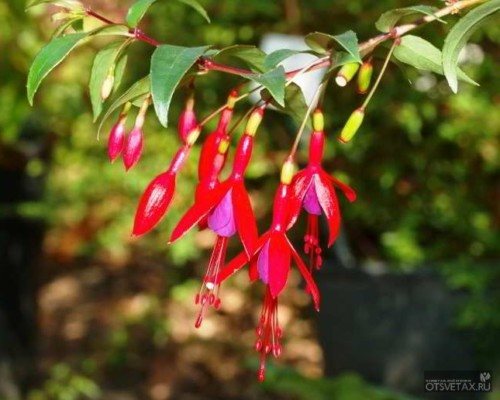

f. coccinea (f. yarko-krasnaya)
Use in landscape design
Due to its high decorativeness and abundant flowering, the flower is often used as a landscape plant. With its help, they create a vertical design of walls, arbors, fences. Ampel and pot crops used as decoration for verandas, terraces, windows, arches. Stamp varieties perfect for decorating playgrounds, paths, local area. Bush varieties used in the design of flower beds and front gardens. Numerous varieties differ in flowering period. This allows you to compose them to create highly decorative landscape compositions.
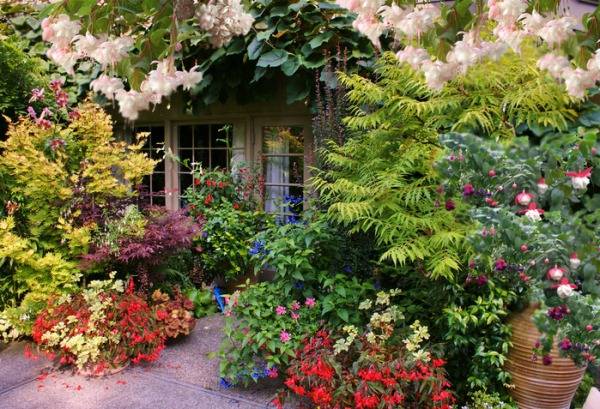

Fuchsia is suitable for cultivation as an ornamental garden culture, so the flowering plant is widely used in landscape design
Fuchsia is a flowering and unpretentious plant. Unsurprisingly, it is often found in homes and gardens. Her fabulous appearance attracts attention at first sight, and the variety of varieties and hybrids allows you to easily surround yourself with an atmosphere of bright colors and intricate shapes.
Dirty pink


The name of this shade is deceptive; it should not cause negative emotions from the one who hears its name. Dirty pink passes from season to season - the color of complete tranquility and tranquility. It matches the color of both casual and formal wear. It will perfectly match with black and gray colors, giving femininity and beauty.
It is pink accessories that are associated with romance and extraordinary tenderness, ease, which every woman strives for. The feeling of airiness, beauty impresses everyone. It is worth trying different looks, complementing them with various accessories, in order to be always a bright and enchanting girl.


Pink color has many shades, each of them is graceful in its own way. It is this color that is always relevant and will emphasize the beauty of a woman. You can safely wear things from last year's collections and be sure that even the most zealous admirers who follow fashion will not be able to find fault with a delicate, beautiful pink outfit.
Fuchsia on the balcony: growing and care
Fuchsia does not survive the heat and lack of moisture in the air. The flowers become small from this, and sometimes the buds do not open at all.
The plant does not tolerate the scorching sun, although the morning rays are good for the flower. Starting from noon until the evening, it is recommended to place the fuchsia in partial shade. The balconies on the east and north sides are best suited for the plant.
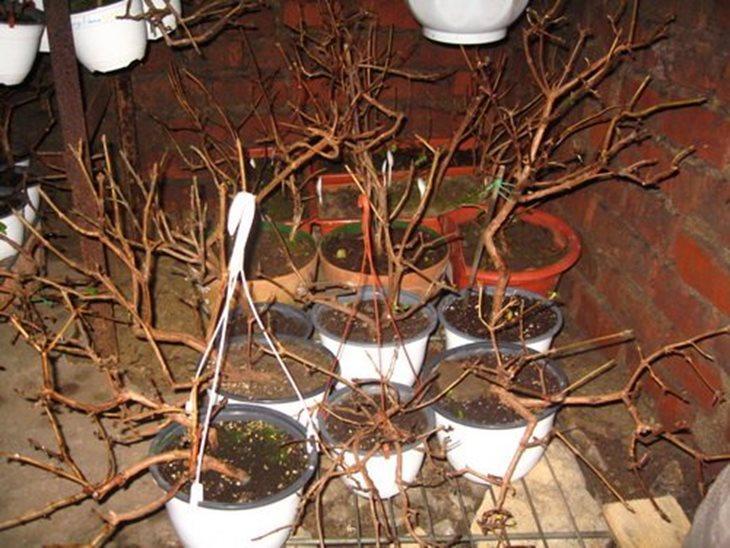

Pots
Fuchsia on the balcony is placed in a pots so that it does not overheat under the scorching rays of the sun. For this it is worth using blinds or curtains. You can try to place the flower so that the sun hits the foliage and buds and does not affect the roots. To do this, it is hung from the wall.
If there is a lack of light and heat, it is necessary to provide the plant with phytolamps or simple fluorescent lamps.
Fuchsia is bad for constant movement during flowering. The plant can simply shed all the buds.
Important! Fuchsia needs a draft and ventilation.


